Product Categories
SHOP BY ARTIST
NEWSLETTER
Products
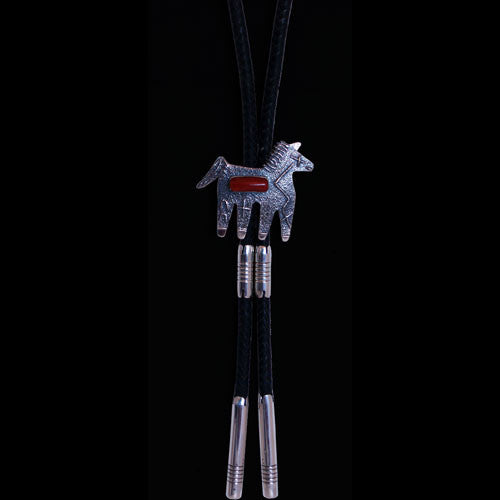
Navajo Coral Spirit Horse Bolo Tie - Jack Tom (#06)
$940.00
Artist: Jack Tom
Navajo Jewelry
41 1/2" total
Horses are exceptionally meaningful to Navajo people; they represent the beasts ridden by the Sun during his daily journeys, freedom and mobility. It is no wonder, then, that Jack Tom has chosen this theme for his latest sand-cast bolo tie. Jack’s craftsmanship is readily apparent, and his choice of Mediterranean coral to enhance this ornate equine is first class. Horse lovers will enjoy this neckwear.
We offer a 100% satisfaction guarantee on every purchase.
About the artist:

Related legends:
Silversmith Work
When and how the Navajo acquired the art of working metals is unknown but there are reasons for supposing that it was introduced among them, or at least more developed and improved upon by them, since the time they have occupied their present country?
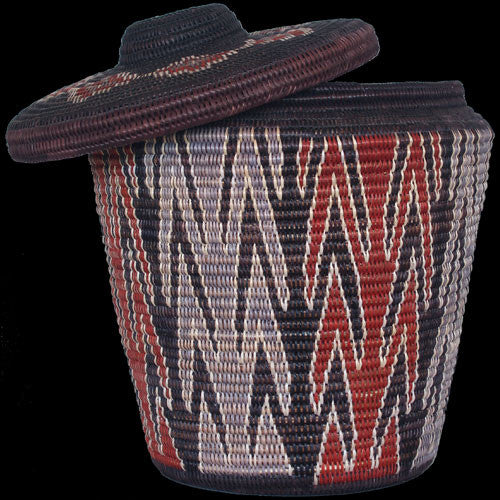
Navajo Corn Basket with Lid - Elsie Holiday (#231)
$7,250.00
Artist: Elsie Holiday
Circumference: 37 3/4" Height: 13 1/2"
Opening: 9 1/2"
Corn is the staff of life. The Navajo people believe they were created from corn. With the aid of deity and sacred buckskin, man sprang from white corn and woman yellow. It is the most sacred of all plants and is used in every ceremony. Elsie Holiday made and dedicated this woven vessel in honor of corn and its significance to her people. This formidable yet elegant vessel is a triumph in the art of basketry, not many weavers would even attempt such a thing. Not only did Elsie attempt it, she mastered it.
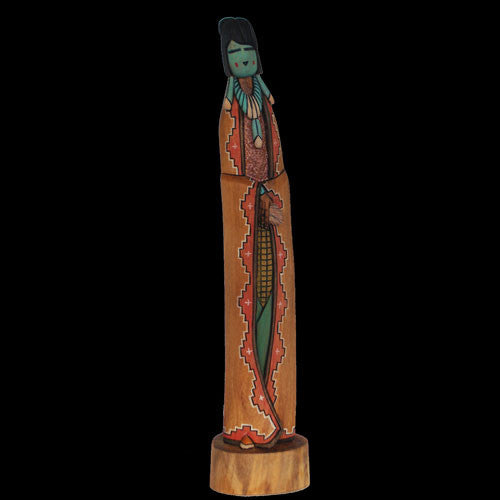
Navajo Corn Maiden Handmade Carving - Dennis Ross (#72)
$375.00
Artist: Dennis Ross
Height: 17" Base: 3 1/2" x 3 1/4"
Slender elegance, that is what Navajo-Hopi carver Dennis Ross has captured in this cottonwood rood carving. The elbows and bends on the San Juan River here in Bluff are where he gets his specimens. Than with his burly hands, delicately carves and paints his way around them to bring them to life. Using yellow corn, which also represents west, indicates abundance and productivity. He has once again captured the essence of this meaningful symbol.
About the artist:

Asked how he first started carving, Dennis Ross answers with a laugh, "My brother - he gave me a knife, and a stone, and a piece of carving wood, and said, 'Here you go'." Dennis was twenty-six years old. His brother, Harry Bert, also gave him a little constructive criticism on that first experiment into the creative world of carving, but Dennis took it from there.
Related legends:
Corn Spirits in Navajo Mythology
Then it was that they moved upward, leaving the dark world behind. They climbed on top of the Four Mountains, which grew upward with them, and they all moved up onto a lighter world. The Wind People brought seeds into the new world, and they planted them:?
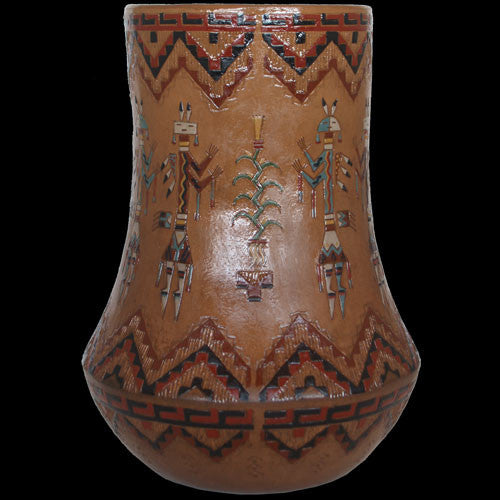
Navajo Corn Yei Pottery Vase - Nancy Chilly (#62)
$315.00
Artist: Nancy Chilly
Circumference: 23 1/4"
Height: 10 1/4"
Opening: 4 1/2"
Nancy Chilly has embossed the Holy People upon this pottery vessel in order to honor them for being benevolent to her high desert people. Nancy creates pottery that portray the Yei-be-chei surrounded by textile patterns and sacred corn. She uses hand dug clay and pinion pitch to form and seal the pottery, the same way her ancestors did. Nancy's pottery is a fabulous example of how the Navajo culture effects their art.
About the artist:

Related legends:
Pottery
The Navajo are relatively recent arrivals to the Southwest. They probably migrated from the north in the 16th Century thereby becoming a part of the Pueblo IV period. The Navajo have made pottery since their arrival; possibly they brought pottery with them during their southern migration. They made a plain and decorated pottery. The plain being considered the older style? More about this legend
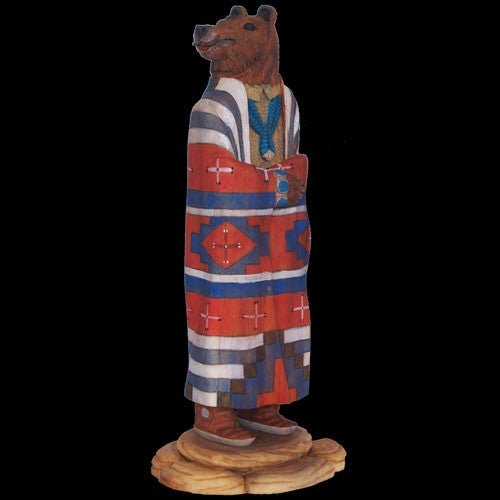
Navajo Cottonwood Bear Carving - Marvin Jim (#372)
$600.00
Artist: Marvin Jim
Base: 6 3/4" x 6"
Height: 15 1/2"
Marvin Jim is back at it, and his folk art is still both fanciful and meaningful. In this case Marvin reminds us that animals once walked with humans and helped make the fourth world habitable for all life forms. Then man, in his infinite wisdom, said or did something to insult the animals. The creatures discarded their garb and returned to the wild, ignoring the shortsighted arrogant two-legged beings they once embraced. Marvin's sculptures remind us that important and treasured relationships can be destroyed in the briefest of thoughtless moments. Guard and protect your valued alliances, they are worth more than material things.
About the artist:

Marvin Jim - Animal Sculptures:
Based upon the Navajo creation tales, the sculptures of Marvin Jim reflect a time long ago, when animals and humans walked and worked together to create a new world. These traditional stories speak of conversations among all beings, of behaving in a manner of mutual respect and of all beings having an equal position in the community. These legends are an essential part of the Navajo culture. The tales are of universal interaction, compassion and tolerance; the things necessary to live a balanced existence.
Related legends:
Bear
The bear was the next chief to be called. He was given a name but he was not satisfied. He became so angry that First Man used the word "shash" to quiet him. The bear repeated it four times, and he said that it had a strange sound, and when one said it aloud one had and awesome feeling. So he went off well content that "shash" should be his name.
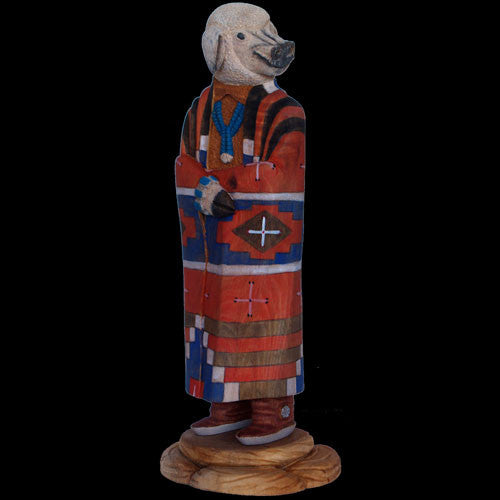
Navajo Cottonwood Sheep Carving - Marvin Jim (#373)
$600.00
Artist: Marvin Jim
Navajo Folk Art
Height: 16"
Base: 6 3/4" x 5 3/4"
We offer a 100% satisfaction guarantee on every purchase.
About the artist:

Marvin Jim - Animal Sculptures:
Based upon the Navajo creation tales, the sculptures of Marvin Jim reflect a time long ago, when animals and humans walked and worked together to create a new world. These traditional stories speak of conversations among all beings, of behaving in a manner of mutual respect and of all beings having an equal position in the community. These legends are an essential part of the Navajo culture. The tales are of universal interaction, compassion and tolerance; the things necessary to live a balanced existence.
Related legends:
Sheep
The gods, of course, had had the animals from the beginning of time. When they arranged the world and planned the pattern of hte stars in the sky, they first laid the glittering objects out on a sheepskin. The Sun, father of the war gods, possessed a flock of sheep in four colors. The beautiful and human myth of the Shooting Chant tells how he offered these to his twin children when they had sought and found him. More about this legend
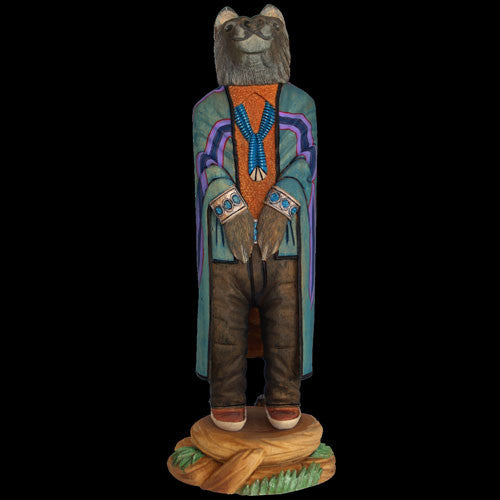
Navajo Cottonwood Wolf Carving - Marvin Jim (#366)
$685.00
Artist: Marvin Jim
Folk Art
Base: 6 3/4" x 6 3/4"
Height: 18 1/2"
Over the past several years, Marvin Jim has developed a carving style all his own. Originally making reproductions of Hopi dolls, Marvin quickly switched his focus to Navajo cultural stories and found his niche. This wolf speaks of a time long ago when animals had human characteristics and enjoyed the company of man. You can see from the smile on this guy’s face it was a happy time.
We offer a 100% satisfaction guarantee on every purchase.
About the artist:

Marvin Jim - Animal Sculptures:
Based upon the Navajo creation tales, the sculptures of Marvin Jim reflect a time long ago, when animals and humans walked and worked together to create a new world. These traditional stories speak of conversations among all beings, of behaving in a manner of mutual respect and of all beings having an equal position in the community. These legends are an essential part of the Navajo culture. The tales are of universal interaction, compassion and tolerance; the things necessary to live a balanced existence.
Related legends:
All Animals
After completion of the ceremony the twins return to teach it to earth people and then depart to become guardians respectively of the thunder storm and of animals.
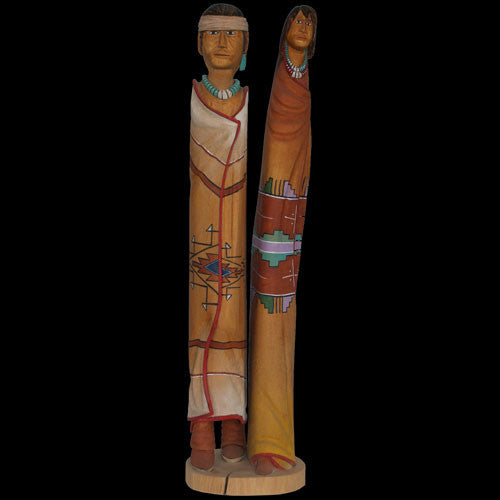
Navajo Couples Cottonwood Root Carving - Harry Bert (#01)
$950.00
Artist: Harry Bert
Navajo Folk Art
Base: 4 3/4" x 4 1/2"
Height: 19"
The love and relationships of Navajo couples between male and female is the theme of this Harry Burt carving. Harry Burt is the one who trained Dennis Ross how to carve; and if you’ve ever seen his work than you’ll know for sure Harry is a master craftsman in the wood whittling art form. Harry sculpted this one out of cottonwood root that he finds floating in the San Juan River. He has loved his honey and loved to carve for a very long time, and this sculpture is a tribute to both.
We offer a 100% satisfaction guarantee on every purchase.
About the artist:
 For sixteen years Harry Bert has been searching out the sandbars of the mighty Colorado and San Juan rivers, and scavenging the shores of Lake Powell. He is looking for driftwood- the water tumbled cottonwood roots that wash up in shoals like bleached bones. It is from these roots that Harry creates new life with his wood sculptures. "I try and make it more human than sculpture," he asserts. "How you see it is how it is in real life." See full biography
For sixteen years Harry Bert has been searching out the sandbars of the mighty Colorado and San Juan rivers, and scavenging the shores of Lake Powell. He is looking for driftwood- the water tumbled cottonwood roots that wash up in shoals like bleached bones. It is from these roots that Harry creates new life with his wood sculptures. "I try and make it more human than sculpture," he asserts. "How you see it is how it is in real life." See full biography
Related legends:
Relationships
First Man burned a crystal for a fire. The crystal belonged to the male and was the symbol of the mind and of clear seeing. When First Man burned it, it was the mind's awakening. First Woman burned her turquoise for a fire. First Woman saw that First Man had a crystal for a fire, and she saw that it was stronger than her turquoise fire. And as she was thinking, First Man spoke to her. "Why do you not come with your fire and we will live together." The woman agreed to this. So instead of the man going to the woman, as is the custom now, the woman went to the man? More about this legend
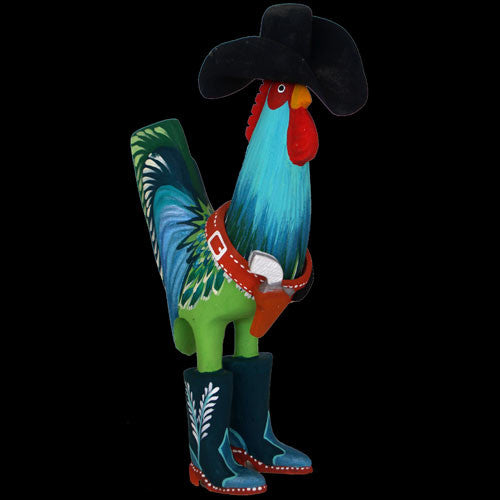
Navajo Cowboy Rooster Cottonwood Root Carving - Matthew Yellowman (#386)
$250.00
Artist: Matthew Yellowman
5 1/2" x 10"
Matthew Yellowman has created his own style of complexly carved and painted folk art. Matt’s detail work is better than most, and his distinctive humor makes his carvings fun to have in the store. You will love displaying this gun slinging outlaw rooster in your personal art collection.
About the artist:

Matthew Yellowman - Navajo Carver: Matthew's carvings are physical representations of the creative energy which has driven him most of his adult life. Whether working in gold mines, upholstering custom vans, or carving whimsical figures, Matthew's self confidence has pushed him to do the best possible work in each career endeavor. See full biography
Related legends:
Small Birds
Ayazh, or ayazh altqas'ai, various small birds, is a general name for the smaller varicolored birds which have no special name. They are said to have been produced from the feathers of the monstrous eagle, tsenahale'. Their feathers, and those of the blue and yellow bird are added to the ket'an, prayersticks, to the masks, and otherwise. More about this legend
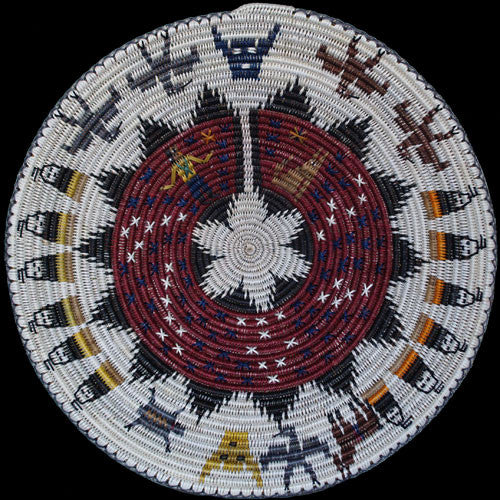
Navajo Coyote & First Man Basket - Lorraine Black (#234)
$3,125.00
Artist: Lorraine Black
Navajo Basket
20" x 3 1/2" deep
Rounds: 35
Lorraine Yazzie Black tells a tall tale with this basket. Tall, as in packed with information. Within the center of Lorraine's weaving there is a depiction of a ceremonial basket with the story of Coyote and First Man Placing the Stars. The story is based on chaos and order, and revolves around the formation of constellations and the Milky Way. Twelve Sky People look down upon the scene, while Eagles serve as intermediaries between the real and spirit worlds. The blue face of the Sun and the yellow features of the Moon make an appearance, as does the Bat who is considered a messenger. Last, but certainly not least, Lorraine's horse Otis has found his way onto the basket, possibly as a way of keeping things grounded. With her weavings Lorraine is a great storyteller, one definitely worth listening to.
We offer a 100% satisfaction guarantee on every purchase.
About the artist:

Inspired by dreams, Lorraine Black's skills have literally elevated basket weaving to new dimensions. Lorraine Black's infectious laugh belies the serious magic her hands conjure up when weaving a basket. Unprecedented in her ideas, Lorraine's baskets are innovative and beautiful. Many of them make good use of texture through over-stitching and the addition of objects such as flint arrowheads or horsehair.
See full biography
Related legends:
First Man
In the East, at the place where the Black Cloud and the White Cloud met, First Man, Atse'hastqin, was formed; and with him was formed the white corn, perfect in shape, with kernels covering the whole ear. Dohonot i'ni is the name of this first seed corn, and it is also the name of the place where the Black Cloud and the White Cloud met. More about this legend
Coyote, First Man and Placing the Stars
After four nights had come and gone First Woman and First Man saw that the sky was too dark. More lights were needed up there for those who wished to travel by night, expecially when the moon did not shine? More about this legend
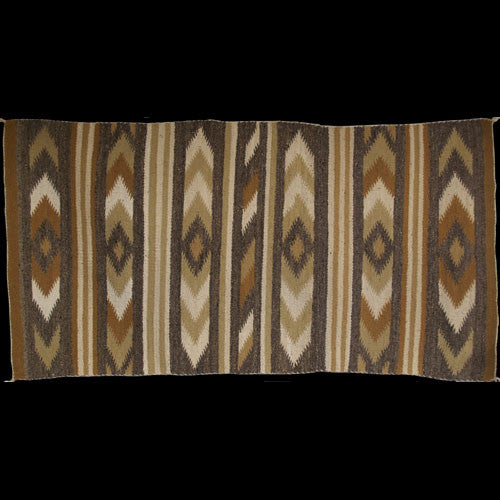
Navajo Crystal Handspun and 100% Vegetal Dye Rug (#48)
$950.00
Navajo Rug
59" x 29 1/2"
This wonderful rug from the Stephen Zolock collection is made with vegetal dyes and woven from hand-spun wool. Woven in the 1960s, this weaving is subtle and well made.
We offer a 100% satisfaction guarantee on every purchase.
Related legends:
Crystals
First Man burned a crystal for a fire. The crystal belonged to the male and was the symbol of the mind and of clear seeing. When First Man burned it, it was the mind's awakening? More about this legend
Weaving
After the medicine woman told the people about the prayersticks she told them that there was a place in the underworld where two rivers crossed. It was called ni tqin'kae tsosi, fine fiber cotton (Indian hemp). There were two persons who brought the seed of that plant, they were spiders. They said that the people were to use the plant instead of skins for their clothing. So this seed was planted in the earth? More about this legend
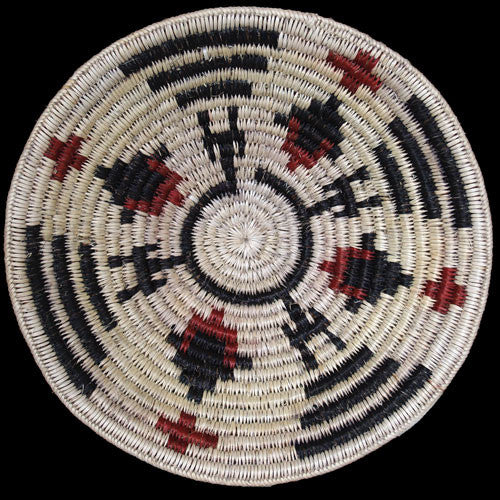
Navajo Cyclone, Wind and Stars Basket - Gene Johnson (#06)
$400.00
Artist: Gene Johnson
Navajo Basket
10 3/4" x 2" deep
Rounds: 19
The Navajo philosophy of nature upholding, guarding and protecting the earthly realm of humans is geometrically represented in this Gene Johnson basket. Images of cyclones, wind and stars surrounding and preserving the Navajo universe are dominantly displayed. Through his woven works of art, Gene is a humble yet clever ambassador for the Navajo tradition and culture.
We offer a 100% satisfaction guarantee on every purchase.
About the artist:

Related legends:
Navajo Core of the Universe
In the Beginning the People lived in several worlds below. Successively they emerged from them to a new world above. In the middle of this new world stood a great rock. Extending through all the previous underworlds and protruding above this one, it was the core of the universe, rooted in time and space. It was oriented to the four directions, and its sides glowed with their corresponding colors white on the east, blue on the south, yellow-red on the west, black on the north?
Cyclone, Wind, Stars
"Then they placed twelve big white cyclones (Niholtso) in the east under the edge of the world, and twelve blue cyclones (Niholtso-doklizh), under the edge of the world at the south, and twelve yellow cyclones (Niholtso-klitsoi) in the west under the edge of the world, and twelve black cyclones under the north. And these forty-eight cyclones are what hold the world up. They also sent all kinds of winds up to the sky to hold up the sky and stars."? More about this legend
Certificate of Authenticity
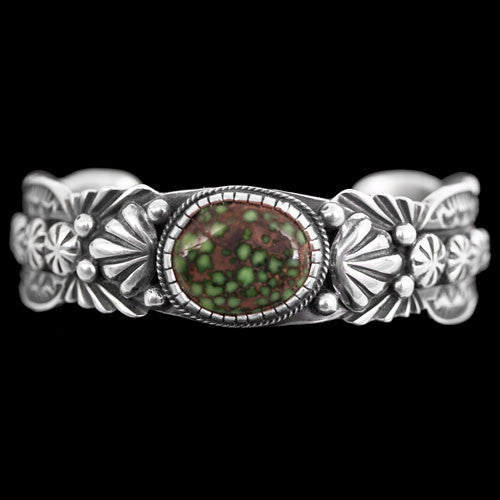
Navajo Damele Turquoise Bracelet - Victor Begay (#31)
$1,125.00
Artist: Victor Begay
Navajo Jewelry
Inner Circumference: 5 1/4"
Opening: 1 1/4"
Total: 6 1/2"
Width: 3/4"
Wow, now this is one beautiful bracelet. Navajo silversmith Victor Begay has stamped, filed and hammered sterling silver into a bracelet that people will admire for ages. Adding a spectacular piece of Natural Gem Grade Damele turquoise, he finished this cuff perfectly. It is rare indeed that we see such a finely conceived and executed bracelet. Order soon, this one won’t last.
We offer a 100% satisfaction guarantee on every purchase.
Damele Turquoise
Damele turquoise jewelry has become highly collectible mainly due to the character and interest found in this wonderfully distinctive turquoise, which is very hard, and visually appealing. Damele turquoise forms in veins and occasionally as nuggets in carbonaceous chert and also diatomaceous earth. Stones from this mine range in color from pure lime-green through bright chartreuse; yellow with black webbing; white; orange and brown; a caramel color turquoise with bright green polka dots, and small black nuggets with bright yellow-green bumps poking out of the black matrix. Typically the turquoise contains black, brown, or tan matrix but Damele turquoise itself is not typical by any standard.
A small, tightly run operation, the Damele mine is located thirty miles east of Austin, Nevada. The mine is located on The Dry Creek Ranch owned by the Damele family. There, they raise unique horses that carry the Damele name. Benny Damele discovered the mine sometime around 1973. Soon thereafter, Clyde Wright became involved in mining the claim and worked it for approximately eighteen years. Tony Cotner, an excellent miner, merchandiser and truly colorful character, has owned the claim since 1990 when he bought it from Benny Damele. Mr. Cotner, also known as “Mean Green", states there is an ancient subtropical zone located beneath the mine that may be responsible for the unusual colors associated with Damele turquoise although he is unsure whether the organic environment has anything to do with the coloration.
Since Damele turquoise is mined by a character and handled by characters at Twin Rocks Trading Post, it is only natural that we prefer stones chockfull of character as well. The next time you are traveling down U.S. Highway 191 in southern Utah, make sure you stop in and visit our cast of characters. We believe you will greatly enjoy the experience.
Chemical composition of turquoise: CuAl,(PO404(OH)8.4H2O.
Related legends:
Silversmith Work
When and how the Navajo acquired the art of working metals is unknown but there are reasons for supposing that it was introduced among them, or at least more developed and improved upon by them, since the time they have occupied their present country?
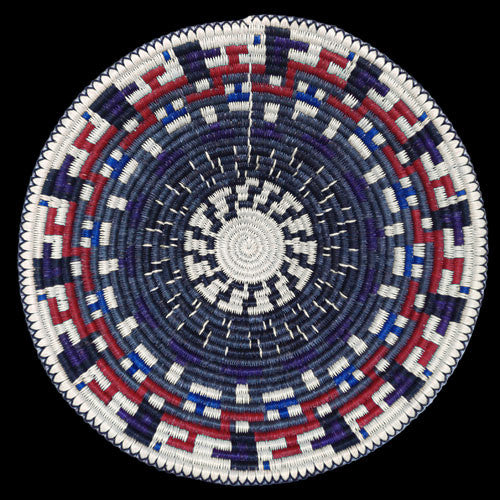
Navajo Doodle Basket - Joann Johnson (#96)
$1,875.00
Artist: Joann Johnson
Navajo Baskets
15 1/2" x 2 3/4" deep
Rounds: 27
Joann Johnson said that this basket started out as; "A doodle in my mind." How she transferred that not so simple thought from her consciousness into and onto this basket is a quality few can master. Finely woven and creatively expressive, this weaving ranks in the top 10 percent of the art of Navajo basketry. The symmetry is spot on and there is even a spirit line worked into the pattern to release negativity and allow access to positive energy. It seems Joann can doodle with the best of them.
We offer a 100% satisfaction guarantee on every purchase.
About the artist:

A fourth generation Navajo basket weaver, Joann Johnson has a passionate awareness of her heritage and history. Born and raised in Monument Valley, she has spent her life in the Navajo heartland, surrounded by the sacred mountains and monuments that tell the stories of her people's past.
See full biography
Related legends:
Navajo Basketry
Basketry is a woman's industry, which is also pursued by the nadle (he changes), hermaphrodites, or men skilled in the arts and industries of both men and women. Basketry, however, is not classified with textile fabrics (yistl'o), but with sewing (nalkhad). It is of interest also that, while the basket is in progress, the sewer is untouched and avoided by the members of her family?
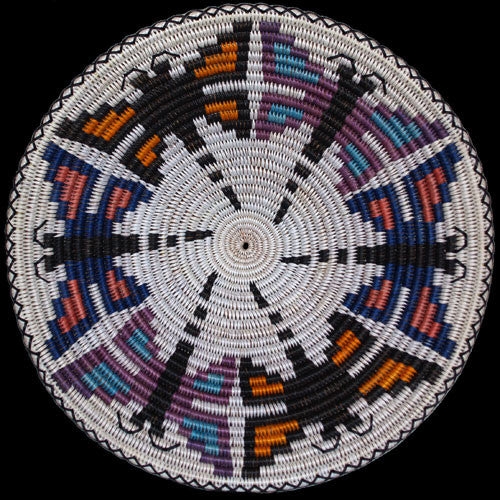
Navajo Dragonfly Basket - Elsie Holiday (#404)
$2,495.00
Artist: Elsie Holiday
Navajo Basket
17" x 3" deep
Rounds: 27
If you are ever lost, lonely and thirsty in the high desert country of the Great American Southwest, find yourself a dragonfly. This is what a Navajo might do, because dragonflies symbolize life by way of water. Follow a dragonfly home and he will show you a way to survive. Elsie Holiday is well aware of the attributes this zippity-doo-daa bug represents, and she wanted to express the idea through her art. Elsie is an amazing weaver; her creativity and quality of weave are unmatched. Do yourself a favor, have a cool drink of water and entertain yourself with a dragonfly.
We offer a 100% satisfaction guarantee on every purchase.
About the artist:

Considered one of the best Navajo basket weavers, Elsie Stone Holiday married into the famed Douglas Mesa family of weavers. Weaving baskets has become almost an addiction for her. "When I go two or three days without weaving I get anxious to get started again," she says. She weaves 12 hours a day, 5 days a week. "Sometimes I think, 'How long can this last?'", she wistfully states, but for now she is content with her art, finding immense satisfaction in creating premier quality baskets.
Related legends:
Water Creatures
A set of four creatures associated with water and rainfall are the main themes of two of the reproductions of Beautyway sandpaintings. These are White Water Monster, Blue Thunder, Big Otter, and variegated (or Many-colored) Water Monster ("Cloud Monster," "Land Monster"). White Water Monster lives underground, a denizen of the lower worlds, and spurts up springs, wells, and streams ("something like a whale")? More about this legend
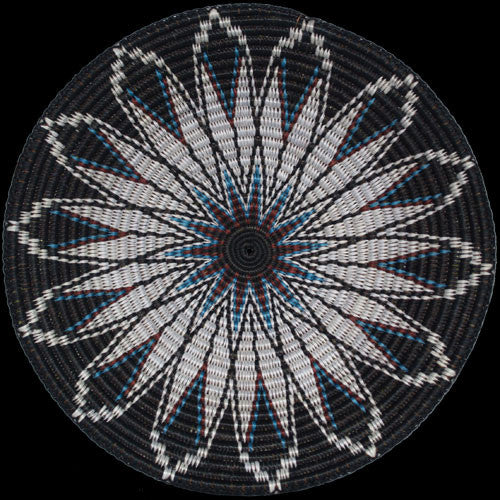
Navajo Eagle Feathers Basket - Elsie Holiday (#417)
$1,995.00
Artist: Elsie Holiday
18" x 2 1/2" deep
Rounds: 27
Elsie Stone Holiday tells us that feathers keep her in constant contact with the higher powers and help her communicate with the Holy People. She can often be found sitting in front of a small smudge fire, waving a feather through the smoke and sending-up prayers. Elsie is a visionary artist with roots of tradition in her soul. Elsie's basket is inspired by her beloved culture, which is evident in her weave.
About the artist:

Considered one of the best Navajo basket weavers, Elsie Stone Holiday married into the famed Douglas Mesa family of weavers. Weaving baskets has become almost an addiction for her. "When I go two or three days without weaving I get anxious to get started again," she says. She weaves 12 hours a day, 5 days a week. "Sometimes I think, 'How long can this last?'", she wistfully states, but for now she is content with her art, finding immense satisfaction in creating premier quality baskets.
Related legends:
Feathers
Feather: As a common denominator the feather figures importantly in Native American myth, method, and tribal practice. The feather is a metaphor for flight, a messenger to the spirit world. Feathers are used decoratively, as prayer symbols, and as designs of power. Attached to an arrow, the feather becomes the universal emblem of the hunt, of flight, of finding the mark? More about this legend
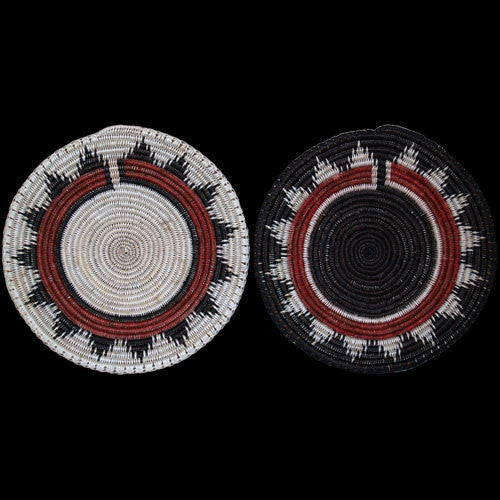
Navajo Eclipse Basket Set - Lorraine Black (#237)
$1,250.00
Artist: Lorraine Black
Navajo Baskets
13" x 1 3/4" deep
Rounds: 23
Lorraine Black has had stars in her eyes lately. She has therefore conceived of an eclipse set that will set you reeling. This positive/negative, sun/moon set is like nothing we have espied. Lorraine, always up for a challenge, has determined to make something based in tradition but completely new. Wow, that’s all we have to say, and we’re stickin’ to it.
We offer a 100% satisfaction guarantee on every purchase.
About the artist:

Inspired by dreams, Lorraine Black's skills have literally elevated basket weaving to new dimensions. Lorraine Black's infectious laugh belies the serious magic her hands conjure up when weaving a basket. Unprecedented in her ideas, Lorraine's baskets are innovative and beautiful. Many of them make good use of texture through over-stitching and the addition of objects such as flint arrowheads or horsehair.
Related legends:
Navajo Basketry
Basketry is a woman's industry, which is also pursued by the nadle (he changes), hermaphrodites, or men skilled in the arts and industries of both men and women. Basketry, however, is not classified with textile fabrics (yistl'o), but with sewing (nalkhad). It is of interest also that, while the basket is in progress, the sewer is untouched and avoided by the members of her family?
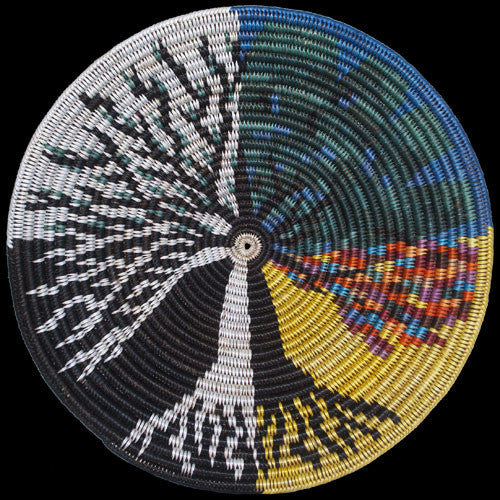
Navajo Elder Tree Four Seasons Basket - Elsie Holiday (#426)
$2,495.00
Artist: Elsie Holiday
16" x 2 3/8" deep
Rounds: 27
Winter, spring, summer and fall, that just about covers it all. Elsie Holiday has woven a basket that embraces the four seasons in grand fashion. She is a master artist when it comes to basketry. Her quality of stitch, symmetry and design make her one of the best weavers ever. In the Navajo culture, Changing Woman (aka Mother Earth) controls the seasons and all green growing things. The Tree of Life symbolizes the Native American connection to the past, personal progress and the embracing, cultivating nature of tradition and culture. There is a whole lot of meaning woven into this basket.
About the artist:

Considered one of the best Navajo basket weavers, Elsie Stone Holiday married into the famed Douglas Mesa family of weavers. Weaving baskets has become almost an addiction for her. "When I go two or three days without weaving I get anxious to get started again," she says. She weaves 12 hours a day, 5 days a week. "Sometimes I think, 'How long can this last?'", she wistfully states, but for now she is content with her art, finding immense satisfaction in creating premier quality baskets.
Related legends:
Seasons & Months
The traditional Navajo year follows the rhythm of the seasons as natural, cosmological order directs specific activities associated with each month for all forms of life on earth. The year begins with Ghaaji' (October), which marks the "dividing of the seasons": hai not only means "winter" but also means "the parting of the seasons," signifying the division between winter and summer? More about this legend
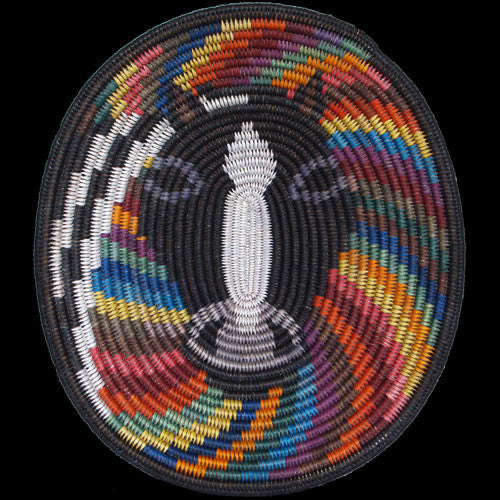
Navajo Equine Colors Basket - Elsie Holiday (#394)
$2,750.00
Artist: Elsie Holiday
Navajo Basket
14" x 16 1/2" x 3" deep
Rounds: 23
Elsie Holiday has started the latest trend in Navajo basketry once again. With her animal face series, she has pioneered a new path, one that is at once innovative and spectacular. Leave it to Elsie to knock your socks off again. This Equine basket is a winner. It might even be the Triple Crown champion.
We offer a 100% satisfaction guarantee on every purchase.
About the artist:

Considered one of the best Navajo basket weavers, Elsie Stone Holiday married into the famed Douglas Mesa family of weavers. Weaving baskets has become almost an addiction for her. "When I go two or three days without weaving I get anxious to get started again," she says. She weaves 12 hours a day, 5 days a week. "Sometimes I think, 'How long can this last?'", she wistfully states, but for now she is content with her art, finding immense satisfaction in creating premier quality baskets.
Related legends:
Horse
Johano-ai starts each day from his hogan, in the east, and rides across the skies to his hogan in the west, carrying the shining golden disk, the sun. He has five horses a horse of turquoise, a horse of white shell, a horse of pearl shell, a horse of red shell, and a horse of coal? More about this legend
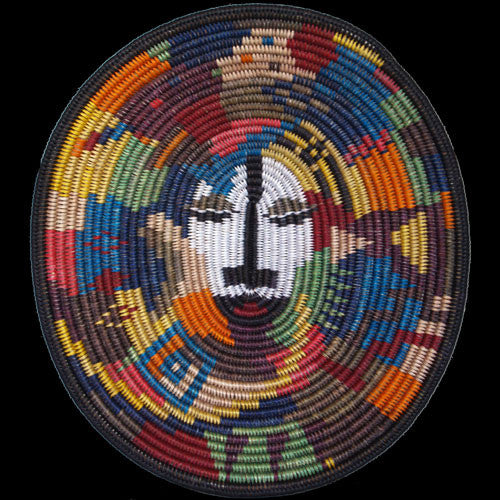
Navajo Eternity Face Basket - Elsie Holiday (#389)
$2,995.00
Artist: Elsie Holiday
Navajo Basket
15 1/2" x 17 1/2" x 1 1/2" deep
Rounds: 26
Elsie Holiday's "Eternity Face" baskets is eerily stunning. Elsie constantly challenges herself to make better and more unusual weavings, and in this one she has outdone herself. Great colors, super weaving and an extraordinary motif combine to make this an exquisite basket.
We offer a 100% satisfaction guarantee on every purchase.
About the artist:

Considered one of the best Navajo basket weavers, Elsie Stone Holiday married into the famed Douglas Mesa family of weavers. Weaving baskets has become almost an addiction for her. "When I go two or three days without weaving I get anxious to get started again," she says. She weaves 12 hours a day, 5 days a week. "Sometimes I think, 'How long can this last?'", she wistfully states, but for now she is content with her art, finding immense satisfaction in creating premier quality baskets.
Related legends:
Dine Emergence/Creation
This is a story told by the Navajo people by word of mouth to the young and old. The Navajo believe there are Five Worlds. We are presently in the fifth world. The first world was a small, dark and water filled world. It was known as the Red World where the flying insects were the first and only people. The second world was blue with the air. The spirit people here were swallows? More about this legend
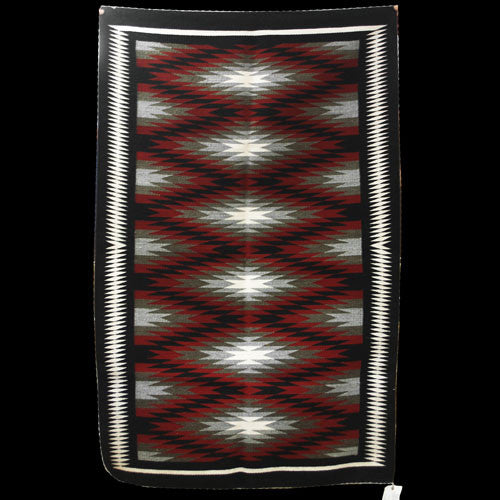
Navajo Eyedazzler Rug - Gabriel Benally (#17)
$1,500.00
Artist: Gabriel Benally
40" x 63"
Gabriel Benally loves to weave Navajo rugs, and he has spent years developing his skills. Storm patterns and eye-dazzlers are his specialty and he has become a master at weaving these styles. In this case Gabriel has once again chosen to amaze us with the eye-dazzler and used the classic Ganado red, black, grey and white color scheme. This one will indeed dazzle your eyes. We always enjoy seeing Gabe and love having his rugs to brighten the store.
About the artist:

Related legends:
Weaving
After the medicine woman told the people about the prayersticks she told them that there was a place in the underworld where two rivers crossed. It was called ni tqin'kae tsosi, fine fiber cotton (Indian hemp). There were two persons who brought the seed of that plant, they were spiders. They said that the people were to use the plant instead of skins for their clothing. So this seed was planted in the earth? More about this legend
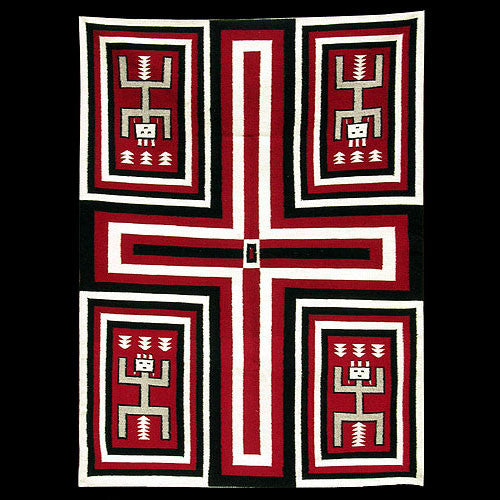
Navajo Four Directional Yeis Rug - Jean Yazzie (#003)
$2,250.00
Artist: Jean Yazzie
A yei’i is a Navajo holy person. As early as the mid-1800’s, Navajo weavers were placing pictorial elements into their weavings. Yei’i figures first appeared in Navajo weavings before the turn of the twentieth century. Considered highly controversial because of their sacred imagery, Navajo weavers nonetheless persisted in incorporating these religious figures into their rugs.
Four areas of influence contributed to the development of Navajo yei and yeibichai weavings. In the early 1900’s, Yanapah, a Navajo weaver married to trader Richard Simpson and living near Farmington, New Mexico, started weaving large single and double figure vertical yei rugs.
Another area of influence in northwest New Mexico came from the Newcomb Trading Post’s partnership with a prominent medicine man named Hastiin Klah who was responsible for the creation of rugs depicting Navajo sandpainting designs. Highly controversial because of their sacred depictions, Klah’s weavings nonetheless had a tremendous influence on weavers of that area and eventually weavers in northwest New Mexico started weaving sacred figures and other design elements into their own Navajo rug creations.
In the early 1920’s, traders in the Lukachukai, Arizona and Shiprock, New Mexico area were encouraging weavers to create multiple figure yei weavings. These early Navajo yei weavings typically had a white or other light-colored background and used a plethora of aniline-dyed yarns for the creation of the yei figures.
Today, this popular style of weaving graces many a fine collection of Navajo rugs. The difference between a yei and yeibichai weaving depends on the depiction of the holy Navajo beings. Yei weavings tend to have static, front facing figures, depicted either singly or more frequently with multiple figures in a horizontal row often surrounded on three sides by a single rainbow yei.
Yeibichai weavings depict the actual ceremonial dance performed in the winter months. An elaborate nine day ceremony, it features male and female yei’i, Talking God, the water sprinkler, fringe mouth yei’i, medicine men and patients. All or some of the above mentioned deities and people will appear in a yeibichai weaving, typically in a more animated form to portray the dancing of the yei during the ceremony.
Yei
Every creature, every aspect of nature has its holy people . . . . even the stinkbug. Sometimes you can see them, if only for an instant. They are represented, some of them, by colors: the blue sky, the evening dusk, the night these are holy people and one prays to them. There are iron people, crystal people, then the other rocks "and such people." There are dawn people, twilight people, air, thunder, and cloud people. One does not talk about such things in nature when they and their holy people are present.
More about this legend
Weaving
After the medicine woman told the people about the prayersticks she told them that there was a place in the underworld where two rivers crossed. It was called ni tqin'kae tsosi, fine fiber cotton (Indian hemp). There were two persons who brought the seed of that plant, they were spiders. They said that the people were to use the plant instead of skins for their clothing. So this seed was planted in the earth? More about this legend
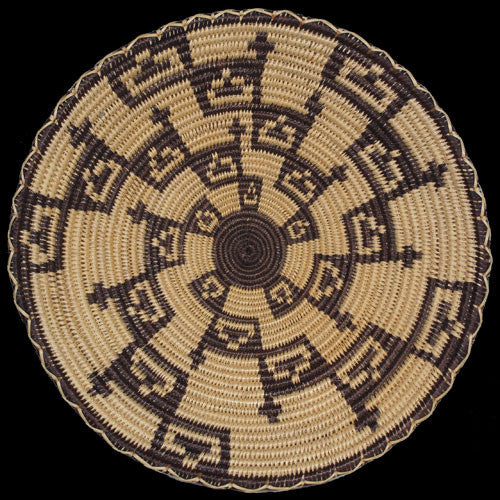
Navajo From The Beginning Basket - Elsie Holiday (#421)
$1,950.00
Artist: Elsie Holiday
14 1/2" x 2" deep
Rounds: 33
This wonderfully stark black and patina aged basket was woven approximately 25 years ago. It is from the Mooney collection, and had comfortably lived in his home in New York before making a temporary home here it Bluff, Utah. At least we hope its temporary. It is an early Elsie Holiday creation, which shows she has been making stellar baskets for a long, long time. We are glad to have it back at Twin Rocks Trading Post.
About the artist:

Considered one of the best Navajo basket weavers, Elsie Stone Holiday married into the famed Douglas Mesa family of weavers. Weaving baskets has become almost an addiction for her. "When I go two or three days without weaving I get anxious to get started again," she says. She weaves 12 hours a day, 5 days a week. "Sometimes I think, 'How long can this last?'", she wistfully states, but for now she is content with her art, finding immense satisfaction in creating premier quality baskets.
Related legends:
Dine Emergence/Creation
This is a story told by the Navajo people by word of mouth to the young and old. The Navajo believe there are Five Worlds. We are presently in the fifth world. The first world was a small, dark and water filled world. It was known as the Red World where the flying insects were the first and only people. The second world was blue with the air. The spirit people here were swallows? More about this legend
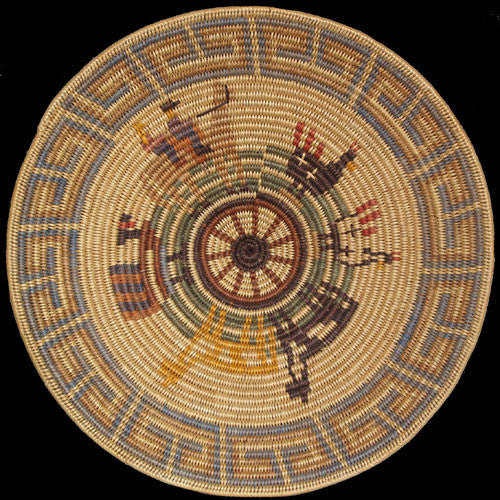
Navajo Fun & Folk Basket - Peggy Black (#108)
$2,500.00
Artist: Peggy Black
Navajo Basket
22 1/2" x 3 3/4" deep
Rounds: 35
Navajo folk art has contributed a great deal to Southwest Native American art. Wanting to celebrate that tradition, several years ago Peggy Black created a basket depicting many of the symbols associated with the movement. Her basket has a turkey, two lamas, two chickens and two people riding a horse. With an aged patina on the front and original color on the back you could say its aged well, something we can all hope for.
We offer a 100% satisfaction guarantee on every purchase.
About the artist:

One of the famous Douglas Mesa basket weavers, there wasn't much question about what Peggy Rock Black would choose to pursue in life. She was born into a family of weavers before she married into an equally talented family of weavers.
Related legends:
Turkey
On this trip his own or his niece's pet turkey accompanies him, following the log along the river bank, Unknown to the hero, the Supernaturals provide the turkey with all kinds of seeds. During the preparations the turkey is troubled, restless, and refuses to eat because he knows the thoughts in his master's mind. The hero instructs the turkey to follow the log. Pg. 167, Plume Way. More about this legend
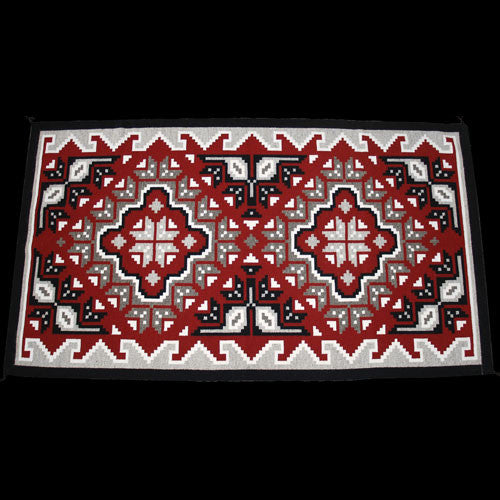
Navajo Ganado Rug - Kathy Nez (#01)
$3,900.00
Artist: Kathy Nez
Navajo Rug
87" x 48"
Navajo weaver Kathy Nez cranked up the big loom and pulled together a truly large Ganado Red rug that is as finely woven, as it is large. Using the traditional color scheme that is deep and rich, Kathy has created a lasting statement of quality, culture and tradition.
We offer a 100% satisfaction guarantee on every purchase.
Related legends:
Weaving
After the medicine woman told the people about the prayersticks she told them that there was a place in the underworld where two rivers crossed. It was called ni tqin'kae tsosi, fine fiber cotton (Indian hemp). There were two persons who brought the seed of that plant, they were spiders. They said that the people were to use the plant instead of skins for their clothing. So this seed was planted in the earth? More about this legend
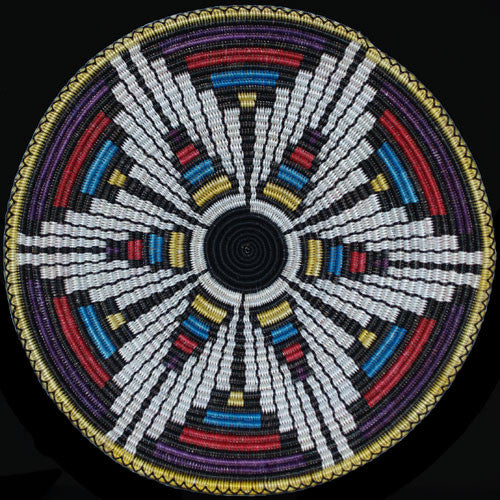
Navajo Germantown Squash Blossom Basket - Elsie Holiday (#368)
$4,375.00
Artist: Elsie Holiday
Navajo Baskets
22" x 3" deep
Rounds: 35
Okay, whatever superlatives you want to apply to this six petal squash blossom basket by Elsie Holiday will be appropriate. Fantastic, unparalleled, amazing? Sure. When people see it in the trading post, they are actually taken aback by its beauty. The weaving takes their breath away. That, however, should come as no surprise. Elsie has been making the best contemporary Navajo basketry for years and years. It's hot, get it while you can!
We offer a 100% satisfaction guarantee on every purchase.
About the artist:

Considered one of the best Navajo basket weavers, Elsie Stone Holiday married into the famed Douglas Mesa family of weavers. Weaving baskets has become almost an addiction for her. "When I go two or three days without weaving I get anxious to get started again," she says. She weaves 12 hours a day, 5 days a week. "Sometimes I think, 'How long can this last?'", she wistfully states, but for now she is content with her art, finding immense satisfaction in creating premier quality baskets.
Related legends:
Navajo Basketry
Basketry is a woman's industry, which is also pursued by the nadle (he changes), hermaphrodites, or men skilled in the arts and industries of both men and women. Basketry, however, is not classified with textile fabrics (yistl'o), but with sewing (nalkhad). It is of interest also that, while the basket is in progress, the sewer is untouched and avoided by the members of her family?
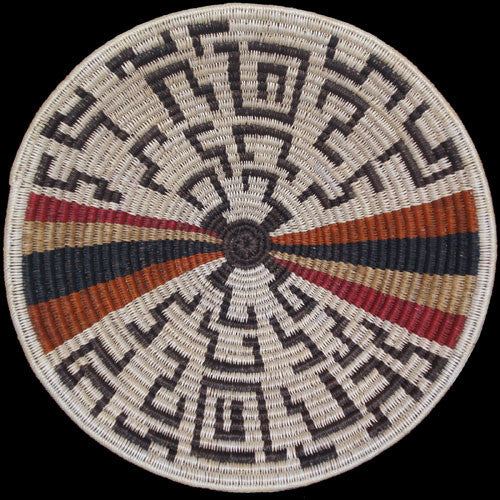
Navajo Going with the Flow Basket - Joann Johnson (#120)
$1,625.00
Artist: Joann Johnson
15" x 2 1/2" deep
Rounds: 28
"Going with the Flow," is the name of Joann Johnson's latest basket. Joann tells us she got the idea from wandering about the edge of Monument Valley. She was looking for wayward sheep and admiring her surroundings when the idea struck her. Once in her head, Joann had to put it into a basket or, as she said, "Otherwise, it would drive me crazy."
About the artist:

A fourth generation Navajo basket weaver, Joann Johnson has a passionate awareness of her heritage and history. Born and raised in Monument Valley, she has spent her life in the Navajo heartland, surrounded by the sacred mountains and monuments that tell the stories of her people's past.
Related legends:
Navajo Basketry
Basketry is a woman's industry, which is also pursued by the nadle (he changes), hermaphrodites, or men skilled in the arts and industries of both men and women. Basketry, however, is not classified with textile fabrics (yistl'o), but with sewing (nalkhad). It is of interest also that, while the basket is in progress, the sewer is untouched and avoided by the members of her family?
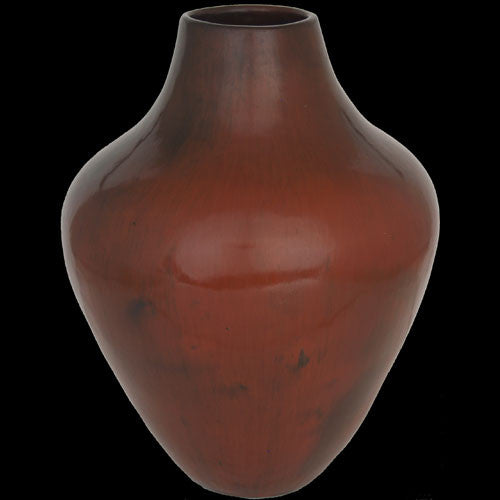
Navajo Hand Coiled and Fired Pottery Vase - Alice Cling (#07)
$845.00
Artist: Alice Cling
Circumference: 26 1/4"
Opening: 2 1/2"
Height: 11"
When asked the meaning of her pottery, Alice Cling told us, "It is about Mother Earth and how she provides for us." Alice tells us that since she digs clay from special earthly sources; builds earthen kilns; fires with pinion wood gathered from local canyons and mesa tops; and seals her pottery with pitch from those same trees, Mother Earth provides everything but the manual labor. When it comes from Alice Cling and Mother Earth, the outcome is fabulous.
About the artist:

Related legends:
Pottery
The Navajo are relatively recent arrivals to the Southwest. They probably migrated from the north in the 16th Century thereby becoming a part of the Pueblo IV period. The Navajo have made pottery since their arrival; possibly they brought pottery with them during their southern migration. They made a plain and decorated pottery. The plain being considered the older style? More about this legend
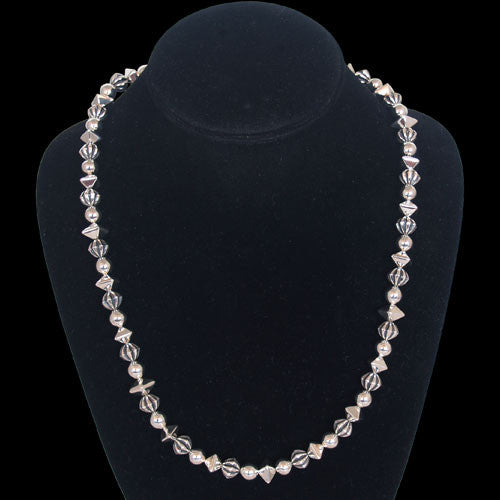
Navajo Handmade Sterling Silver Bead Necklace - Trent Lee (#06)
$1,100.00
Artist: Trent Lee
Trent Lee is taking the art of making "Navajo pearls" to an entirely new level. Not only does he create unique shapes, his finish detail is over the top. Trent learned the art from his father, Allison Snowhawk Lee, and they still work together in the same shop. Handmade beads are difficult to create, since there are numerous steps involved in each individual pearl and not many artists have the patience and attention to detail to work through the process. Luckily Trent does.
Related legends:
Silversmith Work
When and how the Navajo acquired the art of working metals is unknown but there are reasons for supposing that it was introduced among them, or at least more developed and improved upon by them, since the time they have occupied their present country?
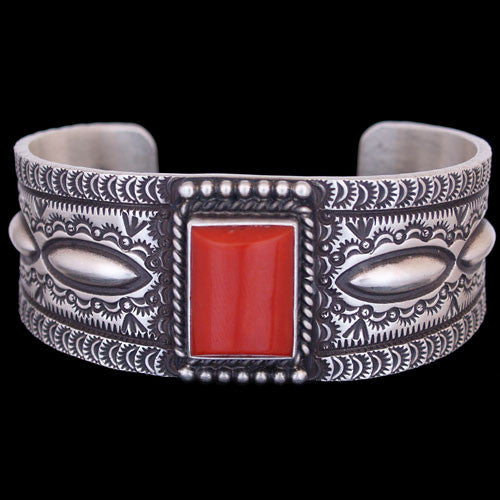
Navajo Handmade Sterling Silver Mediteranean Coral Bracelet - Herman Smith (#02)
$1,250.00
Artist: Herman Smith
Total inner circumference including opening: 6 3/8"
Opening: 1 1/8"
Barry recently negotiated Herman Smith’s wife out of her Mediterranean, blood-red coral bracelet. Barry was so fond of the deep and precise stamping and the great stone, he couldn’t let it go. Herman assured his wife and Barry there would be another forthcoming to maintain martial harmony. The trading post therefore is the owner of another beautiful bracelet.
About the artist:

Related legends:
Silversmith Work
When and how the Navajo acquired the art of working metals is unknown but there are reasons for supposing that it was introduced among them, or at least more developed and improved upon by them, since the time they have occupied their present country?
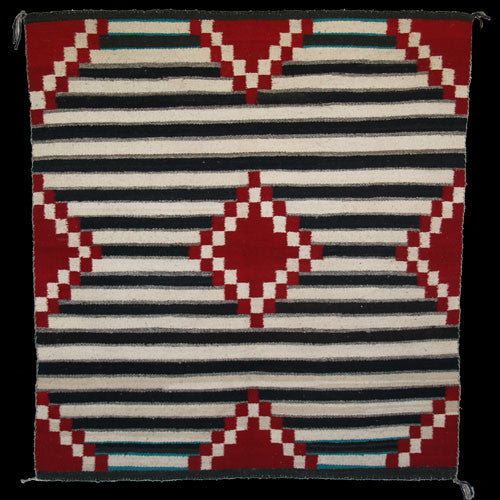
Navajo Handspun Chief Blanket (#45)
$0.00
Navajo Blanket
44" x 49"
Much flora and fauna gave there all in the creation of this third phase Chief's blanket. Hand spun wool, acrylic and vegetable dyes are what this rug is made from. Back in the 1960s a tasteful and talented Navajo weaver created this alluring weaving. The time and effort it took are undocumented, but be assured it took a great deal of each. Blankets such as this are uncommon in today's market, not many people want to shear the sheep, clean the wool, dye it, spin it and then weave the rug. Too much work! See, touch and own a blast from the past with this weaving.
We offer a 100% satisfaction guarantee on every purchase.
Related legends:
Weaving
After the medicine woman told the people about the prayersticks she told them that there was a place in the underworld where two rivers crossed. It was called ni tqin'kae tsosi, fine fiber cotton (Indian hemp). There were two persons who brought the seed of that plant, they were spiders. They said that the people were to use the plant instead of skins for their clothing. So this seed was planted in the earth? More about this legend
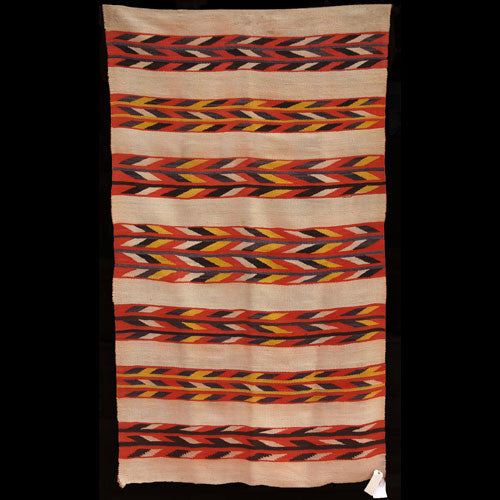
Navajo Handspun Feather Pattern Blanket (#49)
$1,750.00
Navajo Rug
52" x 86"
This banded rug from the Steve Zolock collection was made in the 1940s and collected by Steve in the 1960s. While it shows a little wear, that’s to be expected after about 75 years. The colors are an interesting blend and the wool soft and supple. Steve has asked us to find a new home for this beauty, so if your abode, office or cabin wants one this is for you.
We offer a 100% satisfaction guarantee on every purchase.
Related legends:
Weaving
After the medicine woman told the people about the prayersticks she told them that there was a place in the underworld where two rivers crossed. It was called ni tqin'kae tsosi, fine fiber cotton (Indian hemp). There were two persons who brought the seed of that plant, they were spiders. They said that the people were to use the plant instead of skins for their clothing. So this seed was planted in the earth? More about this legend
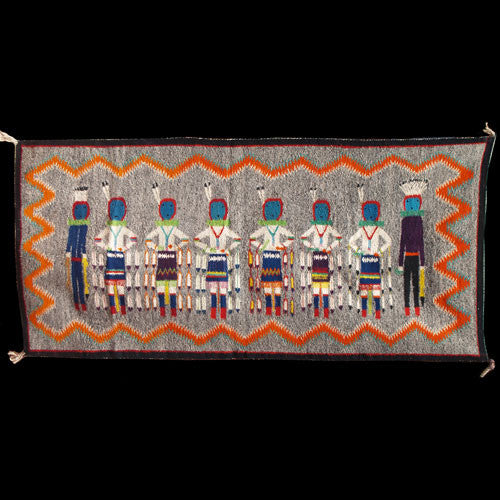
Navajo Handspun Wool Yei Rug (#50)
$2,975.00
Navajo Rug
77" x 36"
Every once in a while a historic weaving appears at Twin Rocks Trading Post that makes us stand straight up and shout, “WOW!” Well, this 1930s Yei weaving is precisely one such rug. Featuring the entire cadre of dancers, including Water Sprinkler, Talking God and six assistants, this rug has color, big time funk, hand-dyed wool, no wear and personality enough to keep you dancing for a lifetime. Say it with me now, “WOW!”
We offer a 100% satisfaction guarantee on every purchase.
Related legends:
Yei
Every creature, every aspect of nature has its holy people . . . . even the stinkbug. Sometimes you can see them, if only for an instant. They are represented, some of them, by colors: the blue sky, the evening dusk, the night these are holy people and one prays to them. There are iron people, crystal people, then the other rocks "and such people." There are dawn people, twilight people, air, thunder, and cloud people. One does not talk about such things in nature when they and their holy people are present.
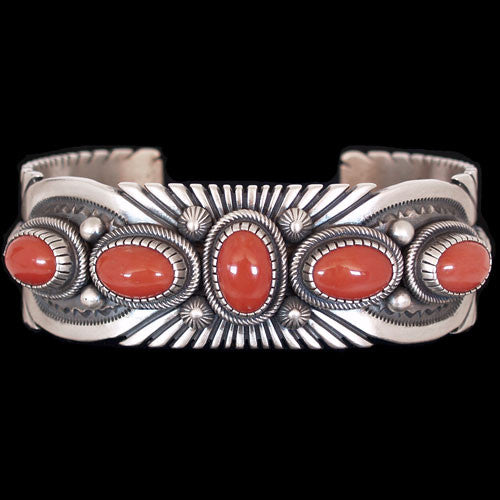
Navajo Heavy Stamped Sterling Silver Red Coral Bracelet - Ray Bennett (#02)
$1,650.00
Artist: Ray Bennett
Navajo Jewelry
Inner Circumference: 5 3/4"
Opening: 1"
Total: 6 3/4"
Width: 1"
Talk about the substantial nature of Navajo jewelry! Ray Bennett has knocked out a bracelet to impress any connoisseur of Native American jewelry. Five extremely well matched cabochons of natural Mediterranean coral grace this piece. Coral was introduced to the Natives of the Great American Southwest back in the 1400s and they have embraced it as their own ever since. Unless you can breathe underwater, do not fall in a lake with this heavyweight on your wrist.
We offer a 100% satisfaction guarantee on every purchase.
Related legends:
Silversmith Work
When and how the Navajo acquired the art of working metals is unknown but there are reasons for supposing that it was introduced among them, or at least more developed and improved upon by them, since the time they have occupied their present country?
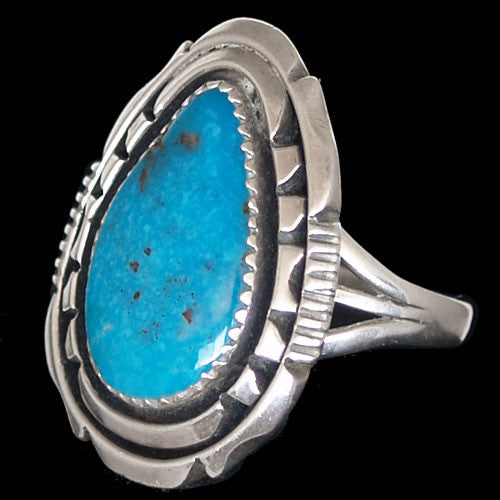
Navajo High Grade Bisbee Turquoise 3 Shank Ring - Will Denetdale (#267)
$350.00
Artist: Will Denetdale
Size: 10
Will Denetdale has taken a fabulous cabochon of high-grade, natural Bisbee turquoise and set it in a double stack setting that enhances it perfectly. The stone was mined back in the 1970s when you could still get Bisbee on a regular basis. No more, the mine has been closed since then and Bisbee of this quality has become rare and is much more desirable. Will is a top-notch artist who works silver in a masterful manner.
Bisbee Turquoise
Bisbee turquoise jewelry is highly coveted by collectors worldwide. The signature look for Bisbee turquoise is a dark lavender blue color with a deep chocolate brown to black matrix. Some of the most distinctively recognizable Indian jewelry has been set and photographed containing classic Bisbee turquoise. As with all turquoise, there is a wide variety of quality from the Bisbee mine where color and matrix patterns can vary a great deal.
The most productive period of the Bisbee turquoise mine was the 1950's and 1960's. The mine has been closed since the early 1970's and is currently owned by Phelps Dodge Corp. Bisbee Mine. Arizona, Cochise County. Turquoise is a copper compound and, in the case of the Bisbee mine, is found in the open pit copper mine known as the Lavender Pit. At this mine, it is typically found as stringers up to a few inches wide; as small nugget-like masses in granite and quartzite; or as minute stringers in massive pyrite.
About the artist:

Will Denetdale - Navajo Jewelry:
One of the most talented Navajo gold and silversmiths currently producing jewelry, Will Denetdale is making an indelible mark in the world of Native American art. His name is becoming famous in his trade; his art a standard by which other pieces may be judged. Will's success as an artist is proportionate to his devotion, and Will Denetdale lives to make jewelry.
Related legends:
Silversmith Work
When and how the Navajo acquired the art of working metals is unknown but there are reasons for supposing that it was introduced among them, or at least more developed and improved upon by them, since the time they have occupied their present country?
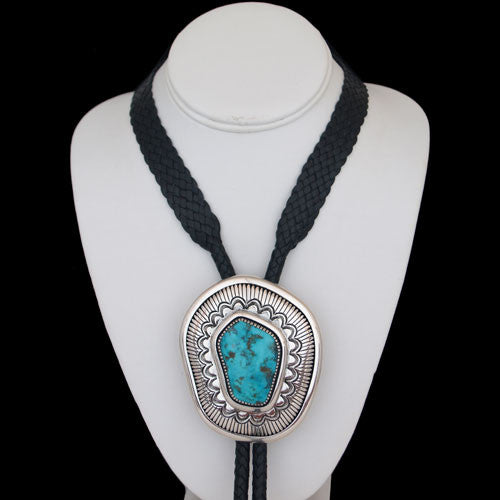
Navajo High Grade Morenci Turquoise Bolo Tie - Allison Lee (#196)
$3,750.00
Artist: Allison Lee
Bolo: 2 3/4" x 3 1/4"
Strap: 50"
Allison Snowhawk Lee has taken a wonderful piece of gem-grade Morenci turquoise and mounted it in one of his classically beautiful hand-fabricated, sterling silver settings. Allison is the most refined finish artist we know, and one of the best all around silversmiths. Who better to set a remarkable stone than a remarkable artist? Beauty, rarity and durability are the three attributes that distinguish a quality, collectible piece of art. All three are definitely present with this amazing bolo tie.
Morenci Turquoise
Morenci Turquoise; Arizona Mine, Morenci, Clifton-Morenci District, Shannon Mountains, Greenlee County, Arizona, USA. An open pit copper mine located in the N1⁄2 Section 16, T4S, R29E (Clifton 15 minute topographic map), owned by Phelps Dodge Corp. Map Reference: 33°5'26"N, 109°21'58"W.
Morenci turquoise was mined in southeastern Arizona until approximately 1990. It is located very near the New Mexico border, and ranges in color from classic high electric blue to light azure. Prehistoric Indians who valued the stone for its deep blue color were the first to discover the deposit. These people adorned themselves with rough-hewn beads and carved talisman made from the mineral
Morenci is often associated with an unusual black matrix of irregular iron pyrite, which looks metallic when polished. Although they are rare, stones with unusual birds-eye patterns, red matrix and an occasional layer of silver have also been found. The Morenci name is derived from the large open pit copper mine owned and operated by the Phelps Dodge Corporation. Early examples of this striking turquoise were of the "lunch box" variety, meaning workers and miners carried them out of the mine.
Morenci is well known; it was one of the first types of American turquoise to find its way to the market and is always difficult to obtain because the mine was depleted so long ago. It is believed that the best Morenci ever produced was discovered in the late 1960's to early 70's. During this time period, the mine produced a high, electric blue variety with iron pyrite inclusions. Since Morenci is no longer being mined, and because of its striking color and unusual matrix combinations, high grade natural Morenci is a valuable, highly collectible mineral.
USGS; Arizona.--In Arizona turquoise ranks first in terms of value of production and is also the best known of its gem materials. Nearly all-important deposits of turquoise are located near copper occurrences or in copper deposits in arid desert regions of the world. Thus, the world famous turquoise deposits associated with certain of the large Arizona copper deposits are to be expected.
Turquoise is, or has been, mined from a number of these copper mines as a byproduct, usually by outside contractors. The financial and operating terms of the collecting contracts vary from mine to mine. Some of the operations are little more than the efforts of individual commercial collectors; some are essentially full-scale mining operations that are simultaneous with, but separate from, the regular mining operations; and still others operate on an on-call basis as turquoise is uncovered by the regular copper mining operation. Regardless of the size or sophistication of the initial mining or recovery operation, the actual turquoise is recovered by careful extraction using hand method.
About the artist:

Allison Lee - Navajo Silversmith:
Speaking of the silver and gold jewelry he hand crafts, Allison Lee's captivating voice is sincere when he says, "One time my uncle told me that everything we build comes from the earth, like the silver that comes from the earth, or the turquoise that comes from the earth. That is a lot of energy. You put it together and you put your heart and mind into a piece. Then sometimes a certain piece of jewelry- I believe- it is made for a certain person. I usually have a ring, or something, that stays with me for about two or three years, until the right person comes along. And then that person buys that piece. I believe that every piece of jewelry that I make is made for somebody out there- it's made for somebody special. Whoever might be having problems, or something like that. In essence, that energy helps that person get help, by wearing pieces that we make. That is the way I look at it.
Related legends:
Silversmith Work
When and how the Navajo acquired the art of working metals is unknown but there are reasons for supposing that it was introduced among them, or at least more developed and improved upon by them, since the time they have occupied their present country?
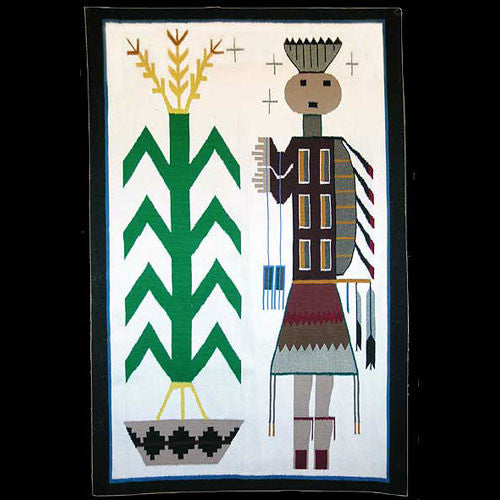
Navajo Humpback Yei Rug - Luana Tso (#29)
$2,975.00
Artist: Luana Tso
Navajo Rugs
38 1/2" x 59"
Luana Tso is widely known for her sand painting weavings. This “Simpson” or “Gallegos Canyon” rug showcases corn, the symbol of fertility, and a single standing yei or holy person. Luana always does great weaving, and this is a standout even for her.
We offer a 100% satisfaction guarantee on every purchase.
About the artist:
 Luana Tso has had a dream for many years now, and it is woven into each one of her Navajo rugs. She has three sons, and for each she dreams of a college education. This bright hope for her children's future keeps her at her loom from eight to fourteen hours a day, weaving traditional patterns, all the while trusting that her efforts will develop a new tradition for her family: higher education. See full biography
Luana Tso has had a dream for many years now, and it is woven into each one of her Navajo rugs. She has three sons, and for each she dreams of a college education. This bright hope for her children's future keeps her at her loom from eight to fourteen hours a day, weaving traditional patterns, all the while trusting that her efforts will develop a new tradition for her family: higher education. See full biography
Related legends:
Yei
Every creature, every aspect of nature has its holy people . . . . even the stinkbug. Sometimes you can see them, if only for an instant. They are represented, some of them, by colors: the blue sky, the evening dusk, the night these are holy people and one prays to them. There are iron people, crystal people, then the other rocks "and such people." There are dawn people, twilight people, air, thunder, and cloud people. One does not talk about such things in nature when they and their holy people are present.
Weaving
After the medicine woman told the people about the prayersticks she told them that there was a place in the underworld where two rivers crossed. It was called ni tqin'kae tsosi, fine fiber cotton (Indian hemp). There were two persons who brought the seed of that plant, they were spiders. They said that the people were to use the plant instead of skins for their clothing. So this seed was planted in the earth? More about this legend
Certificate of Authenticity
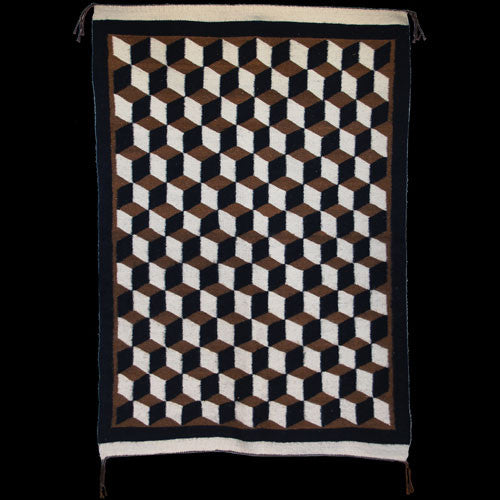
Navajo Illusion Cube Weaving - Elizabeth Joe (#01)
$1,200.00
Artist: Elizabeth Joe
Navajo Rug
31" x 44 1/2"
We sure don’t see many tumbling block rugs around the trading post any more. Likely because they require a great deal of technical skill that is not often being developed in the young ‘uns. Unfortunately the young ‘us ain’t learnin’ the old ways. This vintage weaving by Elizabeth Joe is a fine example of this style of weaving and you should get it before it disappears, altogether.
We offer a 100% satisfaction guarantee on every purchase.
Related legends:
Weaving
After the medicine woman told the people about the prayersticks she told them that there was a place in the underworld where two rivers crossed. It was called ni tqin'kae tsosi, fine fiber cotton (Indian hemp). There were two persons who brought the seed of that plant, they were spiders. They said that the people were to use the plant instead of skins for their clothing. So this seed was planted in the earth? More about this legend
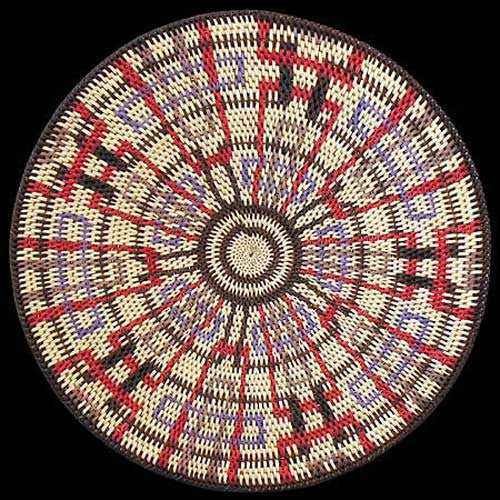
Navajo Interlocken Basket - Elsie Holiday (#117)
$2,500.00
Artist: Elsie Holiday
Navajo Basket
Interlocken
16"
We offer a 100% satisfaction guarantee on every purchase.
About the artist:

Considered one of the best Navajo basket weavers, Elsie Stone Holiday married into the famed Douglas Mesa family of weavers. Weaving baskets has become almost an addiction for her. "When I go two or three days without weaving I get anxious to get started again," she says. She weaves 12 hours a day, 5 days a week. "Sometimes I think, 'How long can this last?'", she wistfully states, but for now she is content with her art, finding immense satisfaction in creating premier quality baskets.
Related legends:
Navajo Basketry
Basketry is a woman's industry, which is also pursued by the nadle (he changes), hermaphrodites, or men skilled in the arts and industries of both men and women. Basketry, however, is not classified with textile fabrics (yistl'o), but with sewing (nalkhad). It is of interest also that, while the basket is in progress, the sewer is untouched and avoided by the members of her family?
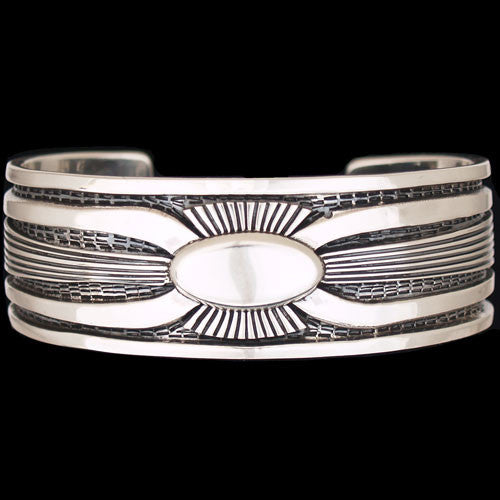
Navajo Ketoh Design Sterling Silver Bracelet - Allison Lee (#181)
$1,150.00
Artist: Allison Lee
Total Inner Circumference including opening: 7 1/2"
Opening: 1 1/4"
About the artist:

Allison Lee - Navajo Silversmith:
Speaking of the silver and gold jewelry he hand crafts, Allison Lee's captivating voice is sincere when he says, "One time my uncle told me that everything we build comes from the earth, like the silver that comes from the earth, or the turquoise that comes from the earth. That is a lot of energy. You put it together and you put your heart and mind into a piece. Then sometimes a certain piece of jewelry- I believe- it is made for a certain person. I usually have a ring, or something, that stays with me for about two or three years, until the right person comes along. And then that person buys that piece. I believe that every piece of jewelry that I make is made for somebody out there- it's made for somebody special. Whoever might be having problems, or something like that. In essence, that energy helps that person get help, by wearing pieces that we make. That is the way I look at it.
Related legends:
Silversmith Work
When and how the Navajo acquired the art of working metals is unknown but there are reasons for supposing that it was introduced among them, or at least more developed and improved upon by them, since the time they have occupied their present country?
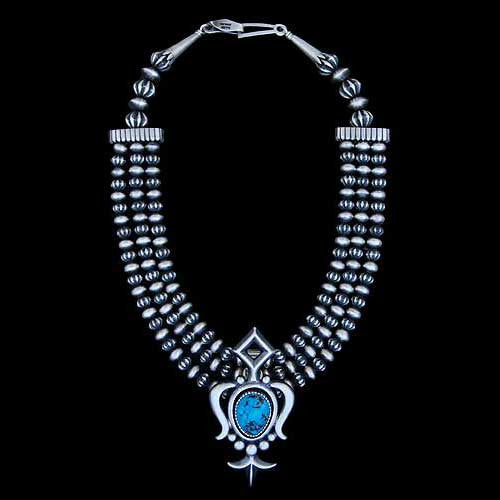
Navajo Kingman Turquoise and Sterling Silver Triple Bead Strand Necklace - Allison Lee (#124)
$3,000.00
Artist: Allison Lee
Navajo Jewelry
Necklace: 18" long
Pendant: 3" tall x 1 1/2" wide
Stone: 7/8" tall x 5/8" wide
We offer a 100% satisfaction guarantee on every purchase.
Kingman Turquoise
Kingman Turquoise comes from a large open-pit copper mine in the Mineral Park Mining District, northwest of Kingman, Arizona and was one of the largest turquoise mines in this country. The area lies in high desert country at an elevation of 3,345 feet and is surrounded by three mountain ranges. The mining district around Kingman, Arizona has always been a large producer of turquoise, at one time the world's largest. First mined by Indians, this area was home to the most extensive prehistoric workings found in Arizona.
The modern production of turquoise dates back to the early 1880’s when James Haas rediscovered these ancient Kingman area mines. Much of the turquoise occurred as seams, masses and veins. The color of natural Kingman turquoise can range from light blue to very dark blue and sometimes tints of green. The matrix is from white, light brown to black and frequently flecked with pyrite and times quartz. The mine became famous for its rounded, bright blue nuggets with black matrix. Few turquoise mines produced nuggets, especially of this quality. In its high-grade form it has always been considered among the top quality American turquoise. With so many thousands of pounds of good quality turquoise produced in the Kingman area over the last one hundred years it is hard to believe that today very little high-grade Kingman turquoise is available.
Other names for Kingman turquoise: Ithaca Peak, The Wall, Tiffany, Courtland, Az., Gleeson
Most desirable: Deep Blue with molybdenum pyrite; Real blue with pyrite; Bird's eye; Water Web; Nuggets
About the artist:

Allison Lee - Navajo Silversmith:
Speaking of the silver and gold jewelry he hand crafts, Allison Lee's captivating voice is sincere when he says, "One time my uncle told me that everything we build comes from the earth, like the silver that comes from the earth, or the turquoise that comes from the earth. That is a lot of energy. You put it together and you put your heart and mind into a piece. Then sometimes a certain piece of jewelry- I believe- it is made for a certain person. I usually have a ring, or something, that stays with me for about two or three years, until the right person comes along. And then that person buys that piece. I believe that every piece of jewelry that I make is made for somebody out there- it's made for somebody special. Whoever might be having problems, or something like that. In essence, that energy helps that person get help, by wearing pieces that we make. That is the way I look at it.
Related legends:
Silversmith Work
When and how the Navajo acquired the art of working metals is unknown but there are reasons for supposing that it was introduced among them, or at least more developed and improved upon by them, since the time they have occupied their present country?
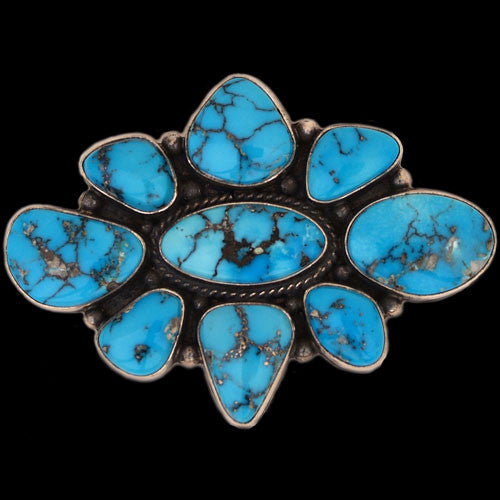
Navajo Kingman Turquoise Brooch - Genevive Ramone (#33)
$825.00
Artist: Genevive Ramone
Navajo Jewelry
2 1/2" x 2"
This pendent-broach contains nine extremely well matched cabochons of high-grade natural Duvall Kingman turquoise. The Kingman mine is located on Turquoise Mountain, which is about 9 miles from Kingman, Arizona. The Duvall designation refers to this turquoise having been excavated from the old diggings of the Duvall mining company, which was focused on producing copper. As we know, copper gives turquoise its sky blue color. Genevive Ramone purchased this satisfying suite of Kingman turquoise from a gem dealer and set them in a simple, yet tasteful setting. The emphasis is on the stones, but the silver work isn’t bad either.
We offer a 100% satisfaction guarantee on every purchase.
Kingman Turquoise
Kingman Turquoise comes from a large open-pit copper mine in the Mineral Park Mining District, northwest of Kingman, Arizona and was one of the largest turquoise mines in this country. The area lies in high desert country at an elevation of 3,345 feet and is surrounded by three mountain ranges. The mining district around Kingman, Arizona has always been a large producer of turquoise, at one time the world's largest. First mined by Indians, this area was home to the most extensive prehistoric workings found in Arizona.
The modern production of turquoise dates back to the early 1880’s when James Haas rediscovered these ancient Kingman area mines. Much of the turquoise occurred as seams, masses and veins. The color of natural Kingman turquoise can range from light blue to very dark blue and sometimes tints of green. The matrix is from white, light brown to black and frequently flecked with pyrite and times quartz. The mine became famous for its rounded, bright blue nuggets with black matrix. Few turquoise mines produced nuggets, especially of this quality. In its high-grade form it has always been considered among the top quality American turquoise. With so many thousands of pounds of good quality turquoise produced in the Kingman area over the last one hundred years it is hard to believe that today very little high-grade Kingman turquoise is available.
Other names for Kingman turquoise: Ithaca Peak, The Wall, Tiffany, Courtland, Az., Gleeson
Most desirable: Deep Blue with molybdenum pyrite; Real blue with pyrite; Bird's eye; Water Web; Nuggets
Related legends:
Silversmith Work
When and how the Navajo acquired the art of working metals is unknown but there are reasons for supposing that it was introduced among them, or at least more developed and improved upon by them, since the time they have occupied their present country?
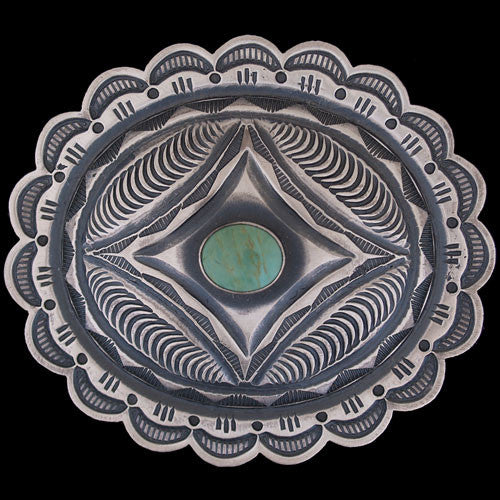
Navajo Kingman Turquoise Sterling Silver Buckle - Roland Dixson (#01)
$320.00
Artist: Roland Dixson
3" x 2 1/2
Good buckles are difficult to acquire these days. So when Barry and I located this concho style buckle by Navajo artist Roland Dixson we were on it like a pullet on a june bug. You will enjoy wearing this with your jeans and cowboy boots. Don’t be chicken belt this one on.
Kingman Turquoise
Kingman Turquoise comes from a large open-pit copper mine in the Mineral Park Mining District, northwest of Kingman, Arizona and was one of the largest turquoise mines in this country. The area lies in high desert country at an elevation of 3,345 feet and is surrounded by three mountain ranges. The mining district around Kingman, Arizona has always been a large producer of turquoise, at one time the world's largest. First mined by Indians, this area was home to the most extensive prehistoric workings found in Arizona.
The modern production of turquoise dates back to the early 1880’s when James Haas rediscovered these ancient Kingman area mines. Much of the turquoise occurred as seams, masses and veins. The color of natural Kingman turquoise can range from light blue to very dark blue and sometimes tints of green. The matrix is from white, light brown to black and frequently flecked with pyrite and times quartz. The mine became famous for its rounded, bright blue nuggets with black matrix. Few turquoise mines produced nuggets, especially of this quality. In its high-grade form it has always been considered among the top quality American turquoise. With so many thousands of pounds of good quality turquoise produced in the Kingman area over the last one hundred years it is hard to believe that today very little high-grade Kingman turquoise is available.
Other names for Kingman turquoise: Ithaca Peak, The Wall, Tiffany, Courtland, Az., Gleeson
Most desirable: Deep Blue with molybdenum pyrite; Real blue with pyrite; Bird's eye; Water Web; Nuggets
Related legends:
Precious Stones
Turquoise; Precious stones have symbolic implications. For example, turquoise if a "collective term for all the precious stones, wealth, or mixed offerings. Good fortune is attributed to this stone." Both white shell and turquoise are emphasized in Kinaalda? More about this legend
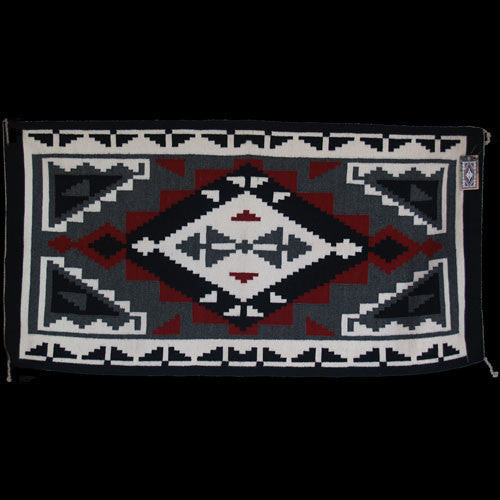
Navajo Klahgatoh Rug - Leta Descheny (#01)
$1,150.00
Artist: Leta Descheny
56" x 29"
Although not quite as well known as the Ganado style, the Klahgatoh pattern is as complex and meaningful as any of the Navajo rug motifs. Leta Descheeny seems to prefer the soft and subtle coloring of the Klahgatoh region for her weaving, and after looking at this particular rug one can certainly appreciate why. Find a place for this weaving in your home or office, and you will enjoy it day after day after day.
Related legends:
Klagetoh Rugs
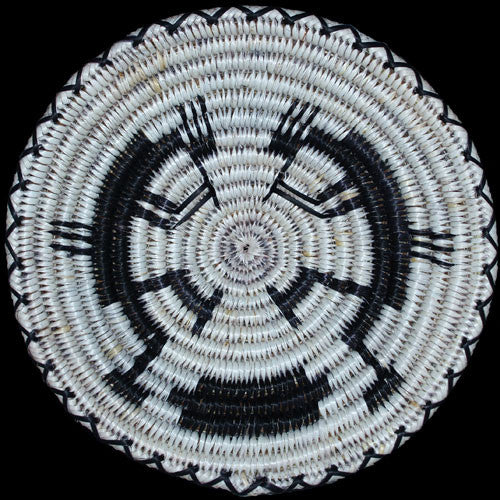
Navajo Kokopelli Basket - Nellie Black (#01)
$250.00
Artist: Nellie Black
Navajo Baskets
9" x 1/2" deep
Rounds: 15
Kokopelli is a cross-cultural icon. To the Navajo he is Water Sprinkler; to the Hopi he represents the Flute Clan. To the Ancient Pueblos . . . well that is anyone's guess, and speculate they do. They being archaeologists, anthropologists and just about everyone out there with a "gist" at the end of their title. Whatever the case, Kokopelli is one of the most portrayed images of the Southwest. So, Navajo basket weaver Nellie Black has woven her very own interpretation of this well-known figure and has done an impressive job. Here's to the flute player!
We offer a 100% satisfaction guarantee on every purchase.
Related legends:
Kokopelli
Much speculation surrounds this mystic figure of the great southwest. He, or she in some cases, is cross cultural, and is one of the most represented figures in American Indian lore. To the ancient people of the southwest he is thought to have been a Toltec, or possibly one of many, traveling up from South America to trade with local inhabitants? More about this legend
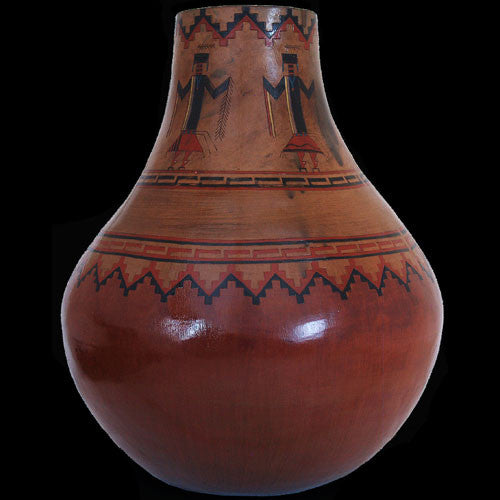
Navajo Large Female Yei Flood Bowl - Lorraine Williams (#36)
$995.00
Artist: Lorraine Williams
Folk Art
Diameter: 40"
Height: 15 1/2"
Opening: 4 1/4"
Big Navajo pottery is a rarity. Although we always ask for it, the potters rarely bring it in. Surely this is because it is so difficult to make, and the risks of it breaking are great. In spite of this, Lorraine Yazzie (Williams) took a chance and created a superb olla. This is one for the museum or serious collector.
We offer a 100% satisfaction guarantee on every purchase.
About the artist:

Lorraine Williams - Navajo Pottery Artist
Lorraine is a master of shape and design and has done much to elevate what Navajo pottery represents. In fact, Lorraine Williams has a message she wants to send to the world: that there is such a thing as Navajo pottery. "I try to push Navajo pottery," she says, "I want it to get noticed". - and it does get noticed. People will come around and say, "This is new, what is this?" and I tell them, "It's Navajo pottery." They say, "I never knew Navajos made pottery." And I say, "Me, too; I never knew we made pottery."
Related legends:
Pottery
The Navajo are relatively recent arrivals to the Southwest. They probably migrated from the north in the 16th Century thereby becoming a part of the Pueblo IV period. The Navajo have made pottery since their arrival; possibly they brought pottery with them during their southern migration. They made a plain and decorated pottery. The plain being considered the older style? More about this legend
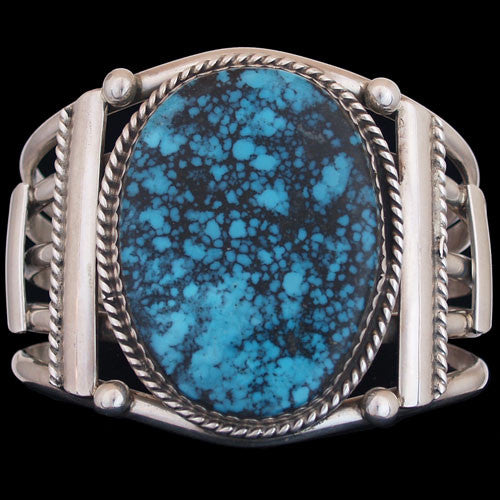
Navajo Large Tibet Turquoise Stone Bracelet (#54)
$750.00
Total inner circumference including opening: 6 7/8"
Opening: 1 1/8"
This traditional style bracelet has plenty of mass and is set with a monumental stone. This bracelet came to us through an estate, and it does not seem to have been worn for any appreciable amount of time. Although we are unfamiliar with the artist, the cuff is Navajo in style and is in pristine condition. The natural stone comes from Tibet and is of high quality. The bracelet is hand fabricated and extremely well made.
Related legends:
Silversmith Work
When and how the Navajo acquired the art of working metals is unknown but there are reasons for supposing that it was introduced among them, or at least more developed and improved upon by them, since the time they have occupied their present country?
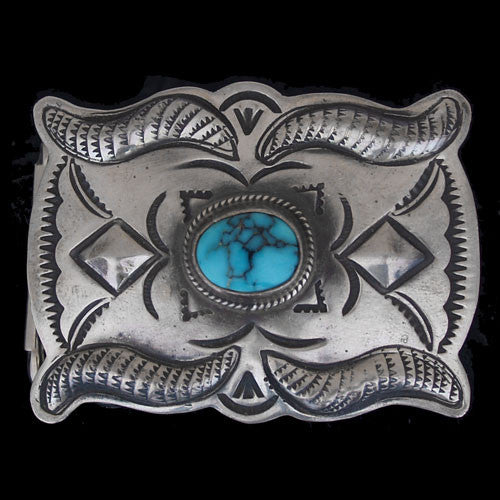
Navajo Lone Mountain Turquoise Buckle - Geraldine Yazzie (#19)
$330.00
Artist: Geraldine Yazzie
Navajo Jewelry
2" x 1 1/2"
Dress yourself up with this fabulous little dress buckle from Navajo silversmith Geraldine Yazzie. This small beauty is the perfect size for all clothing applications, and the spot of Lone Mountain turquoise really sets off Geraldine’s work. Buckle up.
We offer a 100% satisfaction guarantee on every purchase.
Lone Mountain Turquoise
The Lone Mountain turquoise mine is located near Tonapah, in Esmeralda County, Nevada. Since it is known for producing a high percentage of gem-grade turquoise, it is often referred to as a "sweet heart" mine. Originally established in 1920 by Lee Hand, the claim was initially called the Blue Jay Mining Lode. Later, after noting that so many other mines had been named Blue Jay, Hand changed its name to Lone Mountain.
In 1927, at a depth of about 40 feet, Bert Kopenhaver, who had leased the mine from Hand, found the beautiful spider web turquoise that made Lone Mountain one of the top mines in the Southwest. Although it has change hands several times over the years, the mine still produces a small amount of quality material. The Lone Mountain claim is currently owned by Gene Wadell and operated by Chris Lott.
Also known for exquisite, deep blue stones, the mine has historically produced some of the highest quality spider web turquoise in the world. "Fossil turquoise" has also been found in the mine. This was formed when ancient plants and seashells dissolved, leaving only cavities that were later filled with turquoise deposits. Additionally, turquoise nuggets in moss agate have been found. Because of its extraordinary hard nature, Lone Mountain turquoise has the ability to retain its rich color and is therefore a valuable addition to any jewelry collection.
About the artist:
Geraldine Yazzie started creating beautiful silver jewelry in the early 1990’s. Learning from her mother, she supports her own family with her well crafted belts and other forms. She resides on the Navajo reservation in the area of Smith Lake, New Mexico.
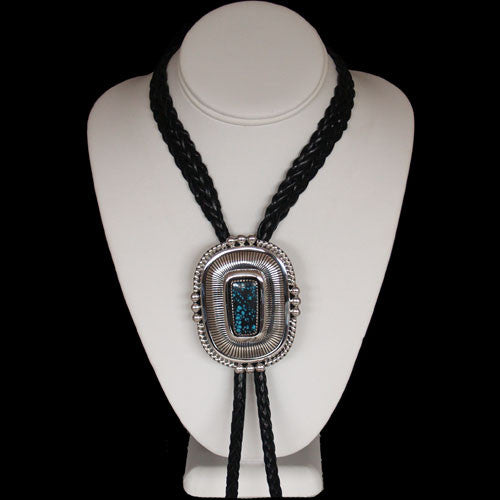
Navajo Lone Mountain Turquoise Sterling Silver Bolo Tie - Allison Lee (#175)
$2,500.00
Artist: Allison Lee
Navajo Jewelry
Bolo: 2 1/2" x 3"
Strap: 43"
Man, if you want a bolo tie to replace your current silk ones, this is it! With a spectacular, and I mean spectacular, piece of Lone Mountain turquoise set in an Allison Lee mounting, you will receive raves when you wear it.
We offer a 100% satisfaction guarantee on every purchase.
Lone Mountain Turquoise
The Lone Mountain turquoise mine is located near Tonapah, in Esmeralda County, Nevada. Since it is known for producing a high percentage of gem-grade turquoise, it is often referred to as a "sweet heart" mine. Originally established in 1920 by Lee Hand, the claim was initially called the Blue Jay Mining Lode. Later, after noting that so many other mines had been named Blue Jay, Hand changed its name to Lone Mountain.
In 1927, at a depth of about 40 feet, Bert Kopenhaver, who had leased the mine from Hand, found the beautiful spider web turquoise that made Lone Mountain one of the top mines in the Southwest. Although it has change hands several times over the years, the mine still produces a small amount of quality material. The Lone Mountain claim is currently owned by Gene Wadell and operated by Chris Lott.
Also known for exquisite, deep blue stones, the mine has historically produced some of the highest quality spider web turquoise in the world. "Fossil turquoise" has also been found in the mine. This was formed when ancient plants and seashells dissolved, leaving only cavities that were later filled with turquoise deposits. Additionally, turquoise nuggets in moss agate have been found. Because of its extraordinary hard nature, Lone Mountain turquoise has the ability to retain its rich color and is therefore a valuable addition to any jewelry collection.
About the artist:

Allison Lee - Navajo Silversmith:
Speaking of the silver and gold jewelry he hand crafts, Allison Lee's captivating voice is sincere when he says, "One time my uncle told me that everything we build comes from the earth, like the silver that comes from the earth, or the turquoise that comes from the earth. That is a lot of energy. You put it together and you put your heart and mind into a piece. Then sometimes a certain piece of jewelry- I believe- it is made for a certain person. I usually have a ring, or something, that stays with me for about two or three years, until the right person comes along. And then that person buys that piece. I believe that every piece of jewelry that I make is made for somebody out there- it's made for somebody special. Whoever might be having problems, or something like that. In essence, that energy helps that person get help, by wearing pieces that we make. That is the way I look at it.
Related legends:
Silversmith Work
When and how the Navajo acquired the art of working metals is unknown but there are reasons for supposing that it was introduced among them, or at least more developed and improved upon by them, since the time they have occupied their present country?
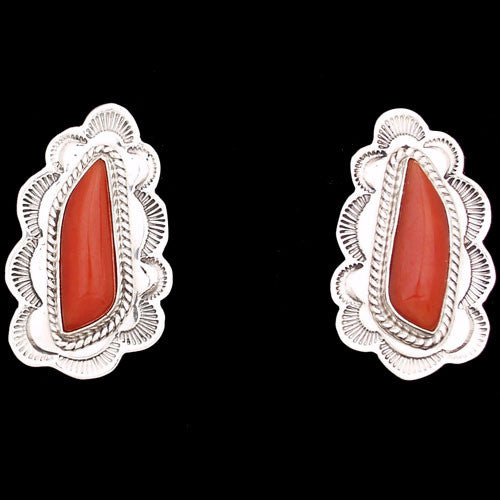
Navajo Mediterranean Coral Post Earrings - Will Denetdale (#269)
$365.00
Artist: Will Denetdale
Clean, simple, traditional, and beautiful. Those are just a few terms to describe Allison Lee’s silverwork. This buckle exhibits all those traits and many more. Allison has a special talent for making jewelry that is versatile and long lasting. You will want to wear this buckle every day, and can.
About the artist:

Will Denetdale - Navajo Jewelry:
One of the most talented Navajo gold and silversmiths currently producing jewelry, Will Denetdale is making an indelible mark in the world of Native American art. His name is becoming famous in his trade; his art a standard by which other pieces may be judged. Will's success as an artist is proportionate to his devotion, and Will Denetdale lives to make jewelry.
Related legends:
Silversmith Work
When and how the Navajo acquired the art of working metals is unknown but there are reasons for supposing that it was introduced among them, or at least more developed and improved upon by them, since the time they have occupied their present country?
More about this legend